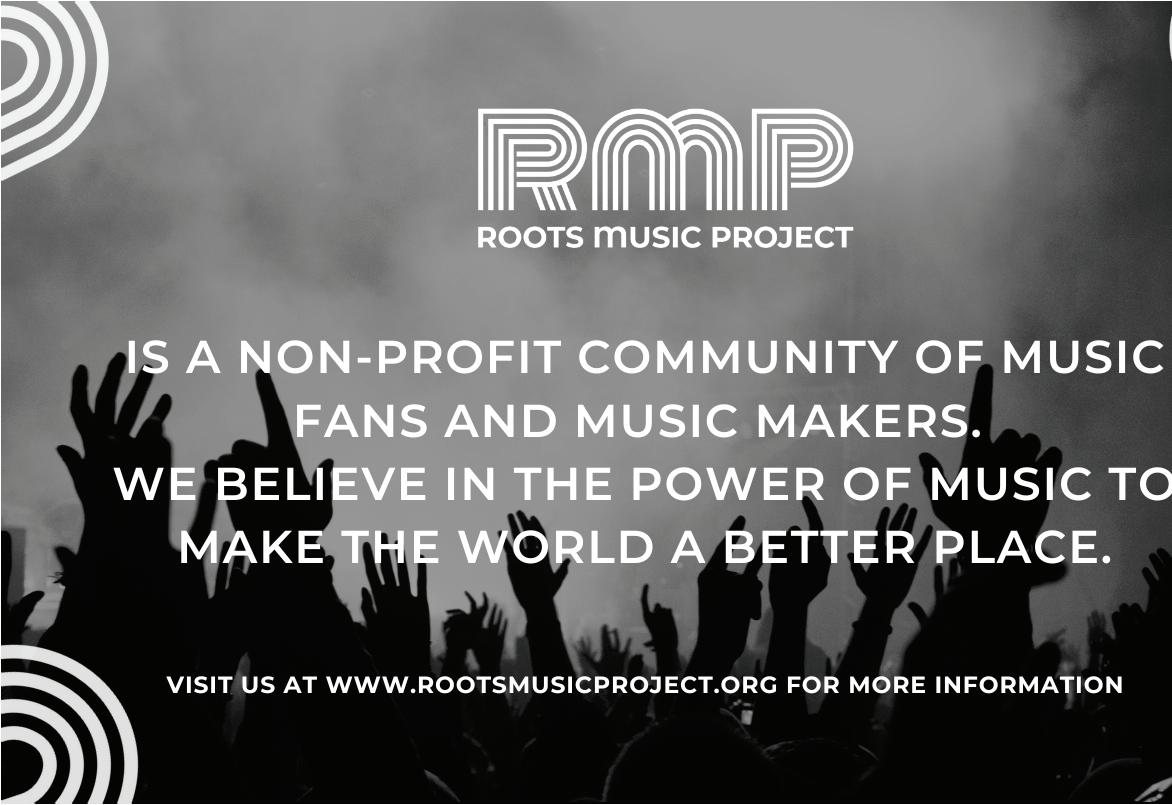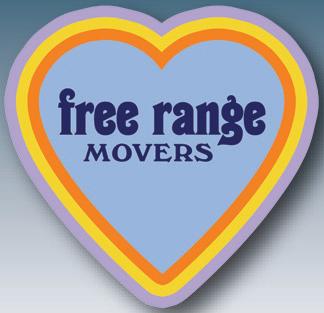














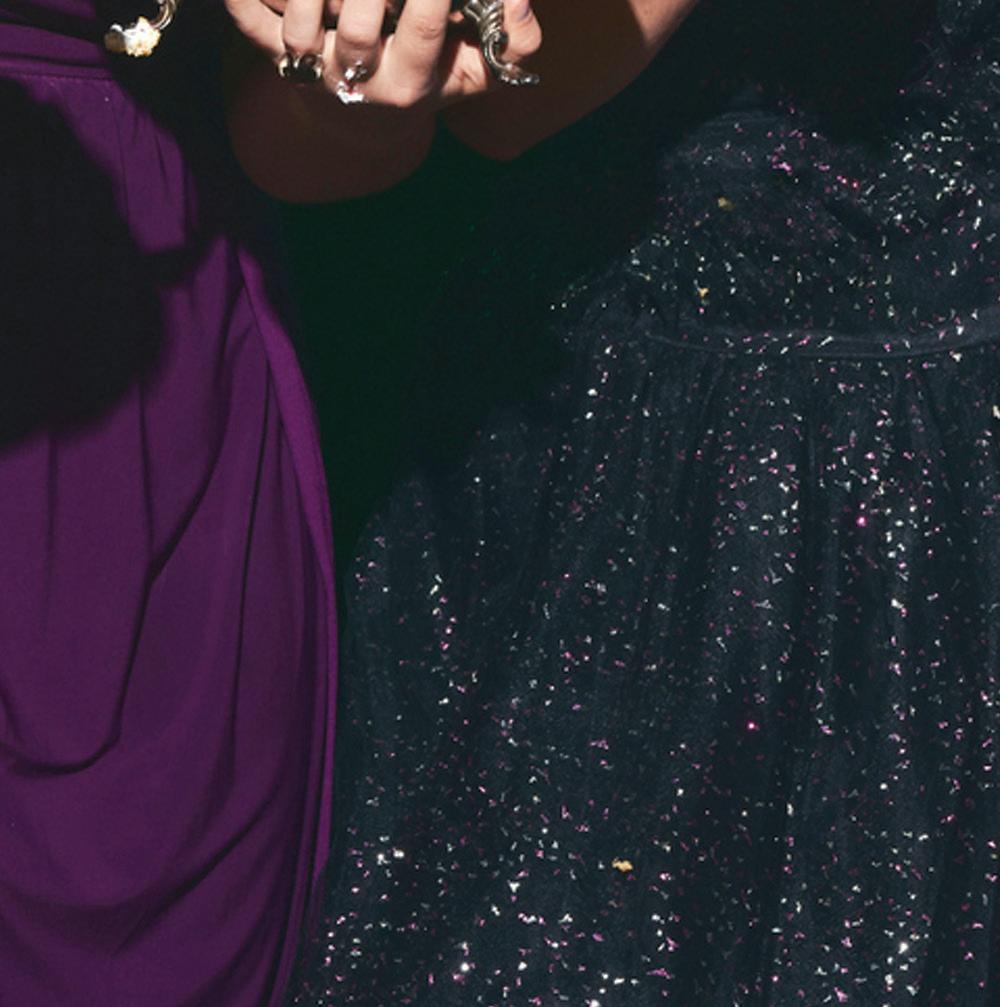
Local bluegrass queens Big Richard take a seat at the table on � Girl Dinner � P. 16


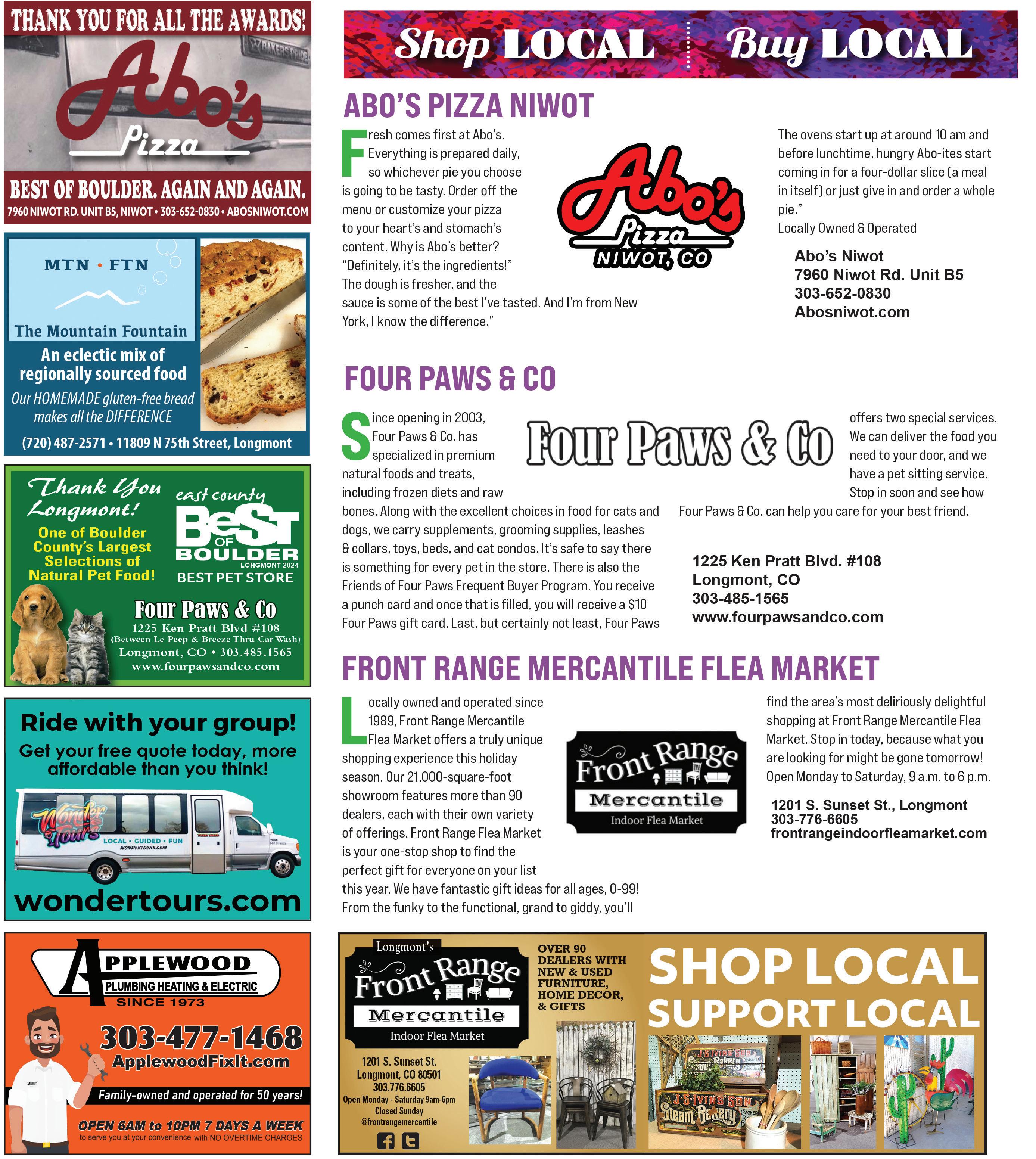






Student-led legislation would require trauma-informed disaster response in Colorado schools
BY MURIEL SOUTIERE
In 2022, Fairview High School students Emma and Molly Weber started the Green New Deal Club, a movement of passionate students working toward climate justice.
After a year of meetings with legislators and administrators, lobbying and petitions, the Green New Deal for Schools was
passed in the Boulder Valley School District (BVSD) and became the first resolution of its kind in the nation. The Green New Deal is part of an initiative created by the Sunrise Movement, a group of community hubs across the country committed to the climate revolution. The Green New Deal for Schools demands
FEBRUARY 13, 2025 Volume 32, Number 26
PUBLISHER: Stewart Sallo
EDITORIAL
EDITOR-IN-CHIEF: Shay Castle
ARTS EDITOR: Jezy J. Gray
REPORTERS: Kaylee Harter, Tyler Hickman
FOOD EDITOR: John Lehndorff
COVER: Jason Innes
CONTRIBUTING WRITERS: Rob Brezsny, Michael J. Casey, Rodney Coates, Junie Joseph, Dan Savage, Muriel Soutiere, Andrea Steffes-Tuttle, Parker Yamasaki
SALES AND MARKETING
DIRECTOR OF ADVERTISING: Kellie Robinson
SENIOR ACCOUNT EXECUTIVE: Matthew Fischer
ACCOUNT EXECUTIVES: Chris Allred, Austen Lopp
SPECIAL PROJECTS MANAGER: Carter Ferryman
MRS. BOULDER WEEKLY: Mari Nevar
PRODUCTION
CREATIVE DIRECTOR: Erik Wogen
GRAPHIC DESIGNER: Chris Sawyer
CIRCULATION
CIRCULATION MANAGER: Cal Winn
CIRCULATION TEAM: Sue Butcher, Ken Rott, Chris Bauer
BUSINESS OFFICE
BOOKKEEPER: Austen Lopp
FOUNDER / CEO: Stewart Sallo
safe and clean buildings, free and healthy lunches, pathways to green jobs, and climate disaster plans and curriculums. Soon after, school districts in Massachusetts (North Hampton), California (Berkeley), Washington D.C., and Illinois (Evanston) followed BVSD in passing the Green New Deal for Schools.
I am particularly passionate about the mental health impacts of climate change and how detrimental these situations can be to students. Three years ago, I watched the Marshall Fire destroy over 1,000 houses and devastate the homes and lives of friends. This experience was traumatizing, and it felt as if no one addressed it well when students arrived back from winter break.
As Boulder County’s only independently owned newspaper, Boulder Weekly is dedicated to illuminating truth, advancing justice and protecting the First Amendment through ethical, no-holds-barred journalism and thought-provoking opinion writing. Free every Thursday since 1993, the Weekly also offers the county’s most comprehensive arts and entertainment coverage. Read the print version, or visit boulderweekly.com. Boulder Weekly does not accept unsolicited editorial submissions. If you’re interested in writing for the paper, please send queries to: editorial@ boulderweekly.com. Any materials sent to Boulder Weekly become the property of the newspaper. 1495 Canyon Boulevard, Suite CO 1, Boulder, CO 80302
Phone: 303.494.5511, FAX: 303.494.2585 editorial@boulderweekly.com www.boulderweekly.com
Boulder Weekly is published every Thursday. No portion may be reproduced in any form without written permission from the publisher. ©2025 Boulder Weekly, Inc., all rights reserved.
Boulder Weekly welcomes your correspondence via email (letters@boulderweekly.com). Preference will be given to short letters (under 300 words) that deal with recent stories or local issues, and letters may be edited for style, length and libel. Letters should include your name, address and telephone number for verification. We do not publish anonymous letters or those signed with pseudonyms. Letters become the property of Boulder Weekly and will be published on our website.
My peers and I were of course saddened, but mostly we were afraid. We had never seen a fire of this magnitude so close in proximity to us, and when teachers and administrators barely gave reasoning or support, it left everyone confused. This fire proved to me how uneducated students and many teachers were on climate change and what to do in the case of a disaster.
The community put most of its focus on physical rebuilding, and while that was a necessary priority, the effect it had on people and students was largely neglected. Some people did try to address it, but in my opinion, they were just as confused as I was.
Because of this experience, myself and a group of my peers became dedicated to increasing awareness and knowledge of climate disaster plans and crises.
The passing of the Green New Deal for BVSD showed our club that we could make a change. One incredibly important and often overlooked topic is climate disaster plans. SB-027, Trauma-informed School Safety Practices, would require school administrations to have specific plans to help students recover and use buildings as designated relief zones for the whole community. Dedicated student members of the Green New Deal Club
We must stand together to reverse the country’s moral and political unraveling
BY JUNIE JOSEPH
The United States has long been a beacon of hope for countless people across the globe. Whether it was the Irish fleeing the potato famine, Jews escaping the horrors of the Holocaust, or those seeking political freedom, economic prosperity, or social stability, America has often been seen as
spent months organizing meetings with legislators, introducing our objective for the legislation and gathering support in hopes of getting this bill passed.
People tend to ignore this aspect because schools technically already have these in place, but the current system is inadequate. Our hub wants the disaster plans to be consistently and effectively communicated to students and for schools to provide support to those concerned about climate issues.

Schools tend to quickly mention what to do in the case of a fire, tornado or earthquake, but we are not told why these events may be occurring. The impact of that topic being skimmed over in school was that when a crisis actually happened, all we could do was sit in our confusion and disbelief. It is vital that young people are educated and empowered to fight the climate crisis and, at a local level, be equipped to handle situations such as the Marshall Fire when they arise.
SB-027 was sponsored by Senator Janice Marchman, SD15, and Rep. Junie Joseph, HD10. It is currently under consideration in the Senate Appropriations Committee.
The passing of climate disaster legislation would make the mental health and education of students around the climate crisis a prime concern. Young people are the future of change in our country and world. We deserve support
and to be taught how to handle climate crises, we deserve to live in a better world, and we know this change is possible.
Muriel Soutiere is a 10th grader at Fairview High School. She is a member of the Green New Deal Club at her school and is passionate about education and mental health support surrounding the climate crisis.
the promised land. A city on a hill, shining brightly as a symbol of opportunity and possibility.
But, as history has shown us, even the brightest stars can fall.
Today, we are witnessing such a fall. Once the beacon of freedom and refuge, America now finds itself in a moment of moral and political unraveling. The metaphor of a “falling star” feels especially apt. Like ancient Rome, which crumbled under the weight of its own contradictions, America — still a young nation — now faces growing fractures. The cracks are becoming impossible to ignore.
As we reflect during this Black History Month, we’re reminded of the extraordinary journey we’ve traveled — one of remarkable progress but also painful setbacks that underscore the cyclical nature of our national story. From the brutality of slavery to the eventual granting of citi-
zenship to Black Americans in 1868, we’ve witnessed some of the most significant turning points in human rights.
This progress was never linear. The rise of Jim Crow laws and the violent struggle for civil rights in the 1960s marked painful chapters where the fight for justice seemed to falter, only to reignite again. These turning points demonstrate a national moral compass that, despite great efforts, often wavered.
The election of Barack Obama in 2008 was a moment of profound optimism. It offered the possibility of a “post-racial” society, a world where racial barriers could finally be dismantled. For many, it was the culmination of a long, hardfought battle for equality.
The rise of President Donald Trump — along with his attempts to dismantle Diversity, Equity and Inclusion (DEI) programs — is a stark reminder that our
moral star does not burn steadily. It flickers, dims and falls, sometimes when we least expect it.
The implications of America’s fallen star extend far beyond our borders. For much of the world, we have been a barometer for righteousness, reliability and moral authority. We have led global efforts to champion human rights and served as a moral compass in calling out injustices committed by others.
As we slip from that pedestal, the rest of the world may feel emboldened to follow suit. Countries that once looked to us as an example of ethical leadership may now feel they can lower their standards of human rights and accountability. America’s loss of moral credibility also weakens our ability to call out our own allies who commit violations or oppress their people. America’s falling star isn’t just a domestic tragedy — it

will reverberate across the globe for years to come.
While we face a moment of moral reckoning, the possibility of redemption still exists. The question as we look to the future is: How can we rise again?
Obama’s presidency ushered in a new era, one that recalibrated our national discourse. It also highlighted a painful reality: the idea that our progress — particularly for BIPOC and LGBTQ+ communities — was perceived by many as a threat to the working class. The belief that only certain groups can thrive, while others are left behind, has created deep divisions. Some feel that the success of marginalized groups must come at the expense of others.
As I look at the state of our nation today, I am reminded of my own neighborhood in Boulder, where I live. For the first time, I find myself feeling a deep fear — not for myself, but for my neighbors. Recently, I learned from a constituent that the U.S. Immigration and Customs Enforcement (ICE) had been patrolling our community.
I’ve always felt safe here, but now, I can’t help but think of how my immigrant neighbors might feel under constant threat. It’s a stark reminder that the same forces that once enforced the brutal system of slavery are still at work today, in new forms. I now understand the historical context of slave patrols in a way I never have before. Back then, it was Black enslaved people who lived in constant fear of being hunted, but today, it is immigrants. Tomorrow, it could be any one of us.
This feeling of fear and alienation is something we must address, for it is deeply tied to the very soul of our nation. It reminds me of the famous words from First They Came by Martin Niemöller:
First they came for the Communists, And I did not speak out, Because I was not a Communist. Then they came for the Socialists, And I did not speak out, Because I was not a Socialist... Then they came for me, And there was no one left To speak out for me.
The lesson is clear. If we do not stand up for the least among us, we risk allowing the cycle of injustice to continue. Ultimately, we all lose.
This Black History Month, we must summon the courage of all those who have stood for justice in the past and find inspiration in their resilience to speak up for those who are still being oppressed today.
The path to a more just and equitable future must be inclusive — one that brings all voices to the table. If we are to rise again, we need to ensure that no one is left behind, whether they are from a community of color, a queer identity, or a working-class background. Only then can we truly move forward, together, in building a society where justice, equality and freedom are not just ideals but realities for all.
As we stand at this crossroads, let us reflect on the lessons of the past, not only as a testament to how far we’ve come but also as a guide for how far we still have to go. Our stars may rise and fall, but the journey toward a better tomorrow is one that we must continue to walk — together.
Junie Joseph is the House District 10 Representative, the Democratic House Majority Caucus co-chair and secretary of the Democratic Black Caucus. She resides in Boulder.
Groundworks Art Lab was incorrectly referred to by their former name, Studio Arts Boulder, in our Kids Camp guide.
Due to a typographical error introduced during the editing process, Jenn Ochs’ Feb. 6 column, “A reignited passion,” incorrectly referred to the Tenderfoot lift as Tenderfood.
What your local officials are up to
BY BOULDER WEEKLY STAFF
On Feb. 13, in addition to a study session on homelessness, council will consider a motion to go into executive session to receive legal advice “on specific legal questions regarding emerging federal guidelines.”
On Feb. 20, council will:
• Vote on amendments to the East Boulder Subcommunity Plan and whether to adopt form-based code, which sets certain design and architectural standards, in the area. The changes are aimed at providing more attainable and affordable housing while also retaining the area’s industrial feel.
The discussion is a continuation from a previous discussion. No public comment will be taken. At the Dec. 5 meeting, council and public commenters said they did not believe the proposed plan and code offered enough flexibility and deferred the vote to allow time for further discussion and modifications. Staff now recommends allowing future developments to opt-out of “the more objective” form-based code review process and use “the more discretionary” site review process.
• Have a brief discussion and take a nod of five to revisit the city’s snow removal policy.
On Feb 11, council:
• Gave direction to city staff on the implementation of new state legislation regarding accessory dwelling units (ADUs) effective June 30. The new bill prohibits cities from requiring property owners to live on site, either in the primary home
or the ADU. Longmont currently has this requirement. Council directed staff to draft into the new municipal code a requirement that ADU applicants must reside on the property before applying, and to allow short-term rentals — any tenancy less than 30 days — only if the property owner lives in the primary dwelling.
• Authorized the city to pursue legal action against Golden Triangle Construction, the contractor for the city’s police and museum storage facility located at 10916 Weld County Road 5. The city claims over $800,000 in water damage has occurred due to water leaks and roof deterioration since 2023. Construction on the building was completed in 2018.
Prior to the regular meeting, council held a closed-door executive session regarding the litigation. According to publicly available documents, the costs to file this civil suit are uncertain, however attorney fees could exceed $200,000.
On Feb. 11, council
• Approved the employment agreement for new city manager Diana Langley. Langley will be paid a base salary of $300,000 annually, plus benefits that include a $500/ month automobile allowance. She will also receive a one-time bonus of 100 hours leave.
The city manager is required to become a resident of the city within six months and remain a resident throughout her tenure. Council voted to hire Langley on Jan. 27 after a six-month search.
• Approved future traffic calming measures at strategic locations including Polk/Dahlia and Via Appia. Implementation and contracts for traffic calming measures will be subject to future meetings and approval.
All agenda items are subject to change. Mark Cathcart contributed reporting.


FRIDAY • 02/14
MY FUNNY VALENTINEA JAZZ SALUTE TO LOVE T RDAY
SATURDAY • 02/15
CANCIONES MEXICANOS
ANCIONES


On paper, Pearl Street is thriving, but restaurants say they’re struggling
BY ANDREA STEFFES-TUTTLE
This is the second in a series of three articles on the topic of fewer people downtown, office vacancies and impacts on local businesses. Read Part 1, “Unoccupied and Uncertain,” at bit.ly/EmptyDowntownBW.
On paper, downtown Boulder is thriving. Visitor numbers rose by 5% in 2024, crime has returned to pre-pandemic levels, and retail vacancy sits at a low 4%, ensuring rents remain high. Millions of visitors are pouring in, spending tens of millions of dollars, and the district has seen steady growth for consecutive years post-COVID.
But speak with the people running restaurants, and you’ll hear a different story — one of rising costs, staffing challenges and razor-thin margins that make survival harder than ever.
The Friday afternoon scene at Mountain Sun last month would have been unthinkable in January 2020. “We had five tables. Normally, pre-pandemic, we would have been on a wait — it’s dead,” says owner Kevin Daly, describing the emptiness of his restaurant in the early days of 2025.
At Gemini, co-owner Michael Mehiel says their worst Friday dinner sales of the past three years was this past November, followed by their weakest Black Friday weekend performance on record. For T/aco owner Peter Waters, the numbers are sobering: Weekday lunch business is down 50% compared to 2019, he says.
According to a recent study by the Downtown Boulder Partnership and Visitors Bureau, two-thirds of downtown restaurants surveyed reported their income has either stagnated or
decreased compared to the previous year.
For restaurant owners, the disconnect between the numbers and their day-today reality is frustrating. While the data paints a picture of progress, many are grappling with declining sales, rising costs and a customer base that isn’t spending the way it once did.
Restaurant owners are quick to name what they perceive as the biggest problems downtown: Workers aren’t coming into their Boulder offices, and everyone else is too scared of rampant crime and homelessness.


Downtown Boulder Partnership (DBP), downtown visitation increased 5.2% in 2024.
Even restaurant owners’ belief that Boulderites don’t come to Pearl Street is less true than in past years. City data shows visits from locals and tourists are on the rise: Residents made nearly 300,000 more trips downtown in 2024 than two years earlier.
“This is not a blighted area,” DBP’s Bettina Swigger said. “This is a thriving destination that people talk about nationally and internationally.”
Department spokesperson. “We learned at one of our recent meetings with the Denver Boulder Partnership that there seem to be some businesses downtown who don’t call the police for perceived minor crimes, and we are currently trying to work with them to address those issues.”
Safety is also about perception, Swigger said. Studies show that vibrant, populated areas feel safer than desolate ones.
“The safety issue downtown is definitely keeping people away,” T/aco’s Waters said.
The first assertion is largely true: Roughly one-third of downtown offices are empty, quadruple the number of prepandemic vacancies.
But observations on crime depressing visitation aren’t supported by the numbers.
“Data shows that while there are fluctuations in criminal activity,” said city spokesperson Shannon Aulabaugh, “overall safety on the Pearl Street Mall is improving,” with violent crime rates falling each of the past three years.
And according to data collected by the
Restaurant owners say the data doesn’t tell the whole story — especially when it comes to crime.
“Reported crime is flat or down because people are like, ‘Great, someone just stole from my shop again. I’ve called 10 times already and nothing ever comes of it, why should I bother wasting my time calling the police right now?’” said T/aco’s Waters.
The city acknowledges that disconnect.
“When we look at safety and crime downtown, we consider not only what the stats show, but also the feedback we get from our community stakeholders,” said Dionne Waugh, a Boulder Police
Although visitation has increased, it hasn’t yet reached pre-pandemic levels. In 2024, the total number of visitors to the Central Area General Improvement District — the downtown area, generally 9th to 18th Streets west-to-east and Spruce to Arapahoe north-south — was nearly 11% lower than in 2019, according to city data.
“There are just fewer people downtown,” Swigger said. “When there are lots of people in an area, it feels safer because there’s more people watching out for you.”
As with crime, total visitation is just one piece of the puzzle. Just because more people are coming downtown doesn’t mean they’re spending money — or spending as much of it as they once did.
In 2024, downtown made up 10% of Boulder’s sales tax revenue. That’s down compared to 2019 when the same area represented 12.5% of the city’s sales tax revenue. While a 2.5% point difference might not seem like much, it represents millions of dollars.
And not all visitors are created equal. A 2024 survey from DBP showed that “out-of-state visitors spend nearly double per visit downtown vs. Boulder County residents.” Locals make up only 25% of visitors to downtown Boulder.
“CU grad week, CU move-in, football games — those are the best weeks of the year,” said Gemini’s Mehiel. “During the summer there are tourists, so we do pretty consistently good numbers.
“What does that all add up to? You’ve got a downtown economy that is supported almost entirely by tourists and the university.”
Shifting consumer habits may also be to blame. As The Atlantic reported last month, “the share of U.S. adults having dinner or drinks with friends on any given night has declined by more than 30% in the past 20 years.”
According to the National Restaurant Association, 74% of restaurant traffic in 2023 came from “off-premises” customers (takeout and delivery), up from 61% before COVID. Patrons who eat on-site spend about 18-34% more than those who order out, according to a 2023 study
from the American Journal of Agricultural Economics
“If we didn’t have DoorDash right now, we would be in worse shape than we are,” Mehiel said. “Doesn’t mean I’m thankful for it.”
One thing is undeniable: It’s gotten more costly to run a restaurant.
“Our entire cost structure has gone up significantly, not to mention the fact that the percentage of margin is shrinking,” Waters said. “If anything, we should be growing significantly greater just to hold the same dollars that we had in 2019.”
According to Waters and Mehiel, the two biggest costs in a restaurant are goods and labor.
“Our biggest cost right now is going to be cost of goods, which is your alcohol and food ingredient costs,” said Waters. “We’ve seen massive increases — about 50% in our cost of goods sold over the last five or six years since COVID started.”

Boulder’s new minimum wage — $15.57 per hour, as of Jan. 1 — “is going to increase our cost by about $42,000 in 2025,” said Justin Hartman, co-owner of OZO Coffee, which has two locations on either end of the Pearl Street Mall.
“With our financials, there’s not a lot of profitability in the two stores on Pearl, so
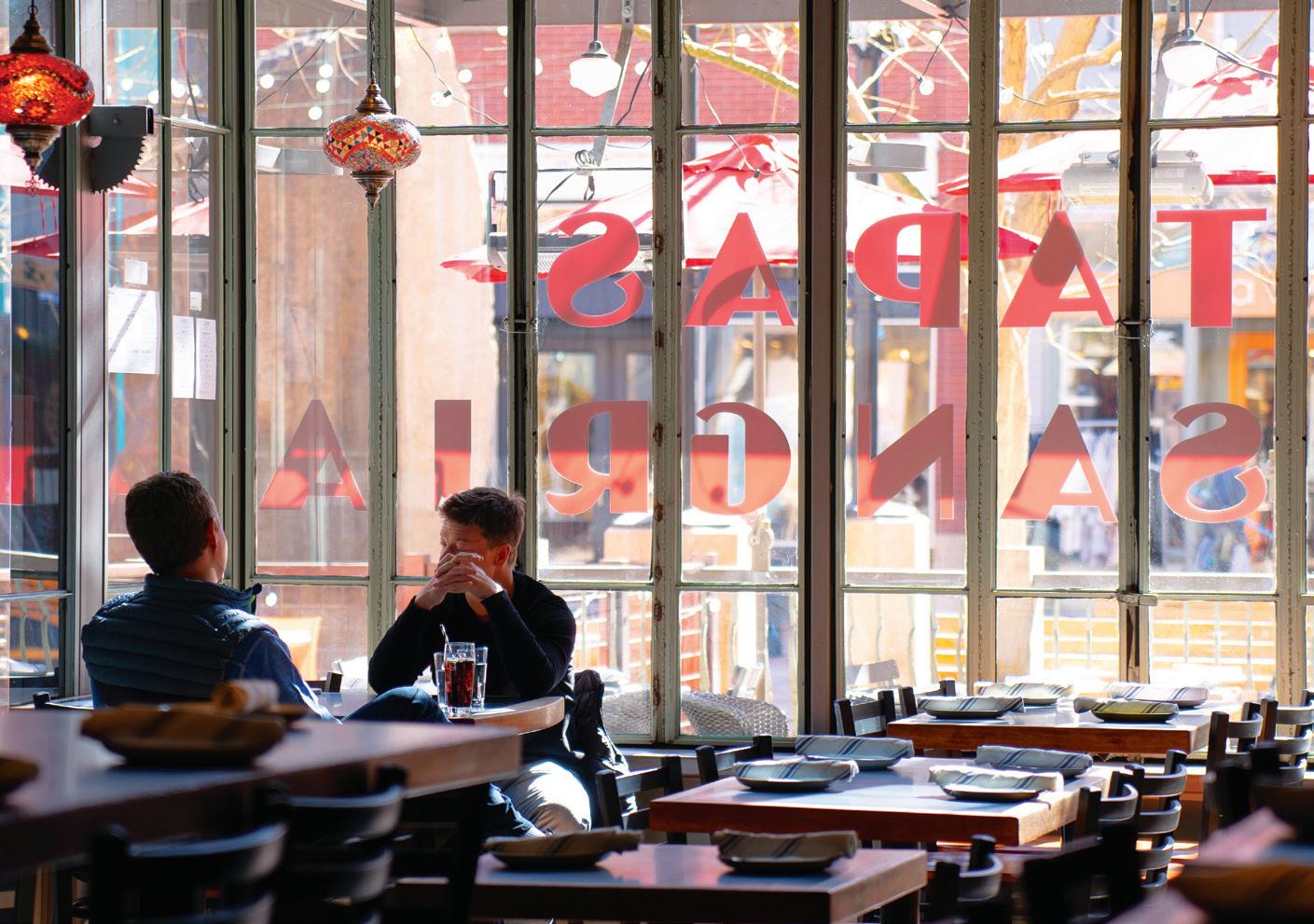
that will put us [in] the red $41,000 or more, depending on the store.”
Several owners suggested that, unless conditions change drastically, the new expense could be what breaks the downtown Boulder restaurant industry.
“It’s going to be very hard for restaurants to overcome the increase in [wage] expense without sales coming back online,” said Mehiel.
Boulder restaurant owners worked with their peers in Denver and legislators at the state capitol on HB-1208, a bill to lower minimum wage for tipped workers. Nontipped employees are generally already earning above minimum wage, owners said, so they don’t benefit from the increases, whereas tipped employees do.
“All my servers are the most highly paid people in the building, and they all got a raise” on Jan. 1, Mehiel said. “All of our cooks and dish people are well above minimum wage, but they did not get a raise.”
The legislation was introduced Tuesday, Feb. 11 at the statehouse.
Owners are also organizing on the local level — which may include a run for Boulder’s city council.
“We need a unified front, which is all of us getting together and agreeing on what our concerns are,” Waters said. “We are looking for representation amongst business owners. We have not decided on a candidate.”
Outside of government action, restaurant owners downtown are urging the community to rally for revival.
“The conversation begins now, and it needs to be expedient,” Mehiel said. “Pearl Street has a great offering, and we have to get the word out.”
Tyler Hickman contributed reporting.
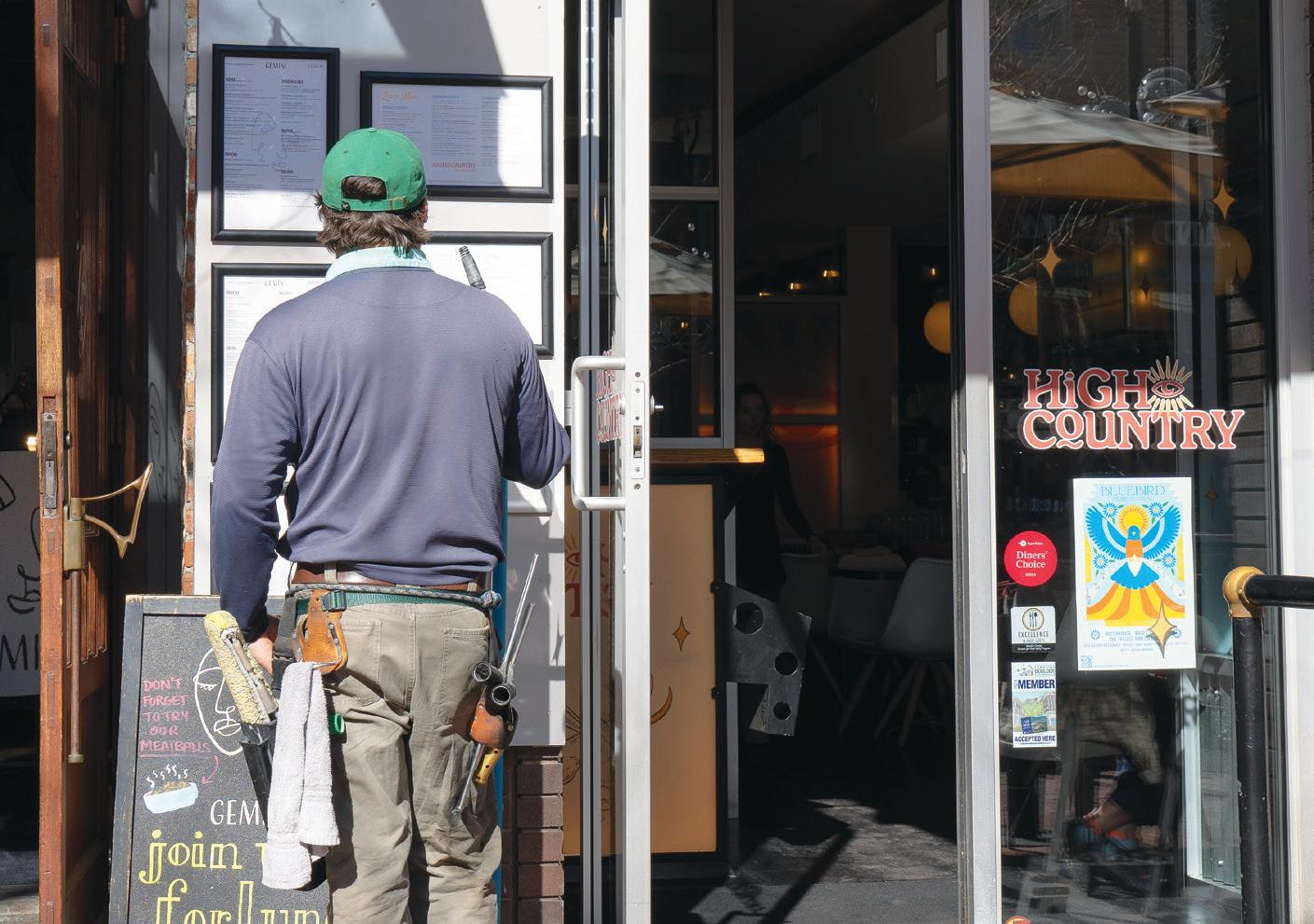









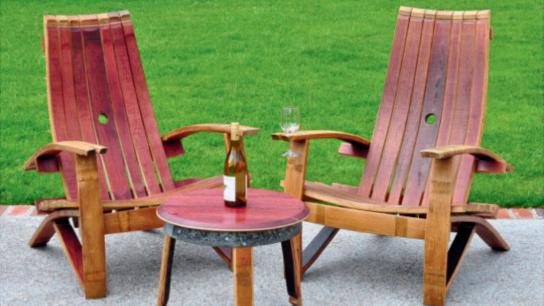



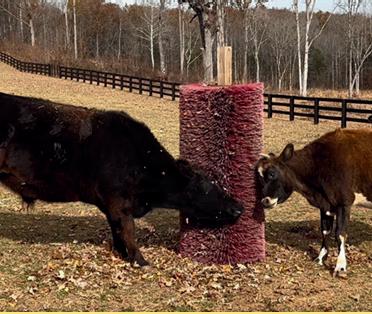










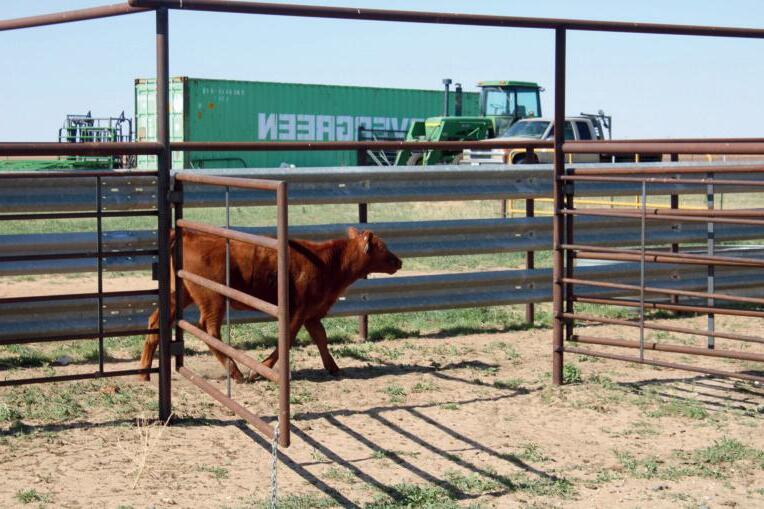
BY TYLER HICKMAN
A walkable, car-free West Pearl Street could be returning to downtown Boulder if a group of residents have their way. The Pearl for You campaign, launched last week, is petitioning to place a measure on the 2025 ballot that would close two blocks of West Pearl Street to private traffic, an attempt to return to a pedestrian-focused, outdoor dining area created during the pandemic.
Pearl Street was previously closed to cars from 9th to 11th during the spring of 2020 through the fall of 2022. Despite support from the city’s Transportation Advisory Board (TAB) and residents — in a 2023 city questionnaire, 86% of respondents supported making the twoblock closure permanent — the area was reopened to traffic.
Pearl for You is looking to reopen the debate. Closing West Pearl to traffic will create a “community space” that will support “public use, outdoor dining, and street activations including art installations, green spaces, and community
activities,” according to the campaign’s website.
In its decision to reopen the street to cars, officials cited concern from business owners worried about the impacts of eliminating drive-up parking and street access. The proposal would close the streets to all private traffic, with the exception of emergency vehicles and for commercial use by the businesses.
The petition will need 3,401 supporters by May 28 to be placed on the November ballot.
Boulder County will sell its North Broadway Complex, according to a Feb. 4 press release. The announcement comes after the county’s purchase of a building located at 2525 28th St. for $14.2 million in Dec. 2024.
“After careful consideration, Boulder County will not pursue continued ownership and redevelopment of the North Broadway Complex, focusing instead on advancing operations at the new Boulder Hub location,” the press release said. The transition of services is expected to take over a year.
The facility at 1333 Iris Ave. currently houses Workforce Boulder County, which offers job, financial planning and recruitment services to residents and businesses.
According to county estimates, the move will reduce the Boulder-based
Preserve Boulder’s baseball history; save Iris Fields bit.ly/BallfieldsBW
office’s footprint by 17%, slash operational costs by $15 million and reduce energy costs by $1.7 million over the next eight years.
The sale may impact the baseball fields west of the county complex. Officials from North Boulder Little League confirmed via email they will be able to use the fields through 2025; a memorandum of understanding with the county governs access.
It is still unclear who the potential buyer of the facility will be, but the county sees “significant opportunity for reuse” for the Iris Avenue location because of its access to transit and existing infrastructure.
There will be input opportunities for community members wishing to share their perspective on potential reuse during the 2025 Boulder Valley Comprehensive Plan update process as early as this spring.
King Soopers filed a temporary restraining order against striking workers on Tuesday, Feb. 11 in the Denver District Court to “protect the well-being of
everyone,” according to a press release.A statement from United Food and Commercial Workers Local Union 7 (UFCW 7) calls the order an attempt to “distract the public with lawfare” rather than “have an open and honest discussion.”
“The fact that the Company is effectively suing its own workers is particularly galling,” the Feb. 11 UFCW 7 release states. “Indeed, the Company’s suit literally complains that workers who are picketing in subzero weather are using portable heating devices.”
The restraining order comes on the heels of the Friday, Feb. 7 lawsuit King Soopers filed against UFCW 7, claiming the union — currently organizing a 77-store strike across the Front Range — violated the National Labor Relations Act.
While the litigation ensues, another group of UFCW Local 7 worker contracts are set to expire on Feb. 15. Stores in Longmont, Loveland and Fort Collins may vote the following week to join the other Front Range strikers.
“A large part of me doubts that Longmont will reach that point before the Denver side settles its issues, but there’s strong solidarity with Denver if it comes to it,” a Longmont King Soopers worker and Local UFCW 7 member told Boulder Weekly in January. The worker wished to remain unnamed so as not to jeopardize their employment.


























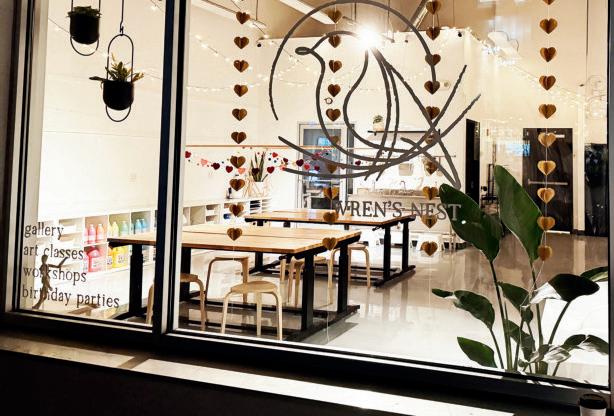





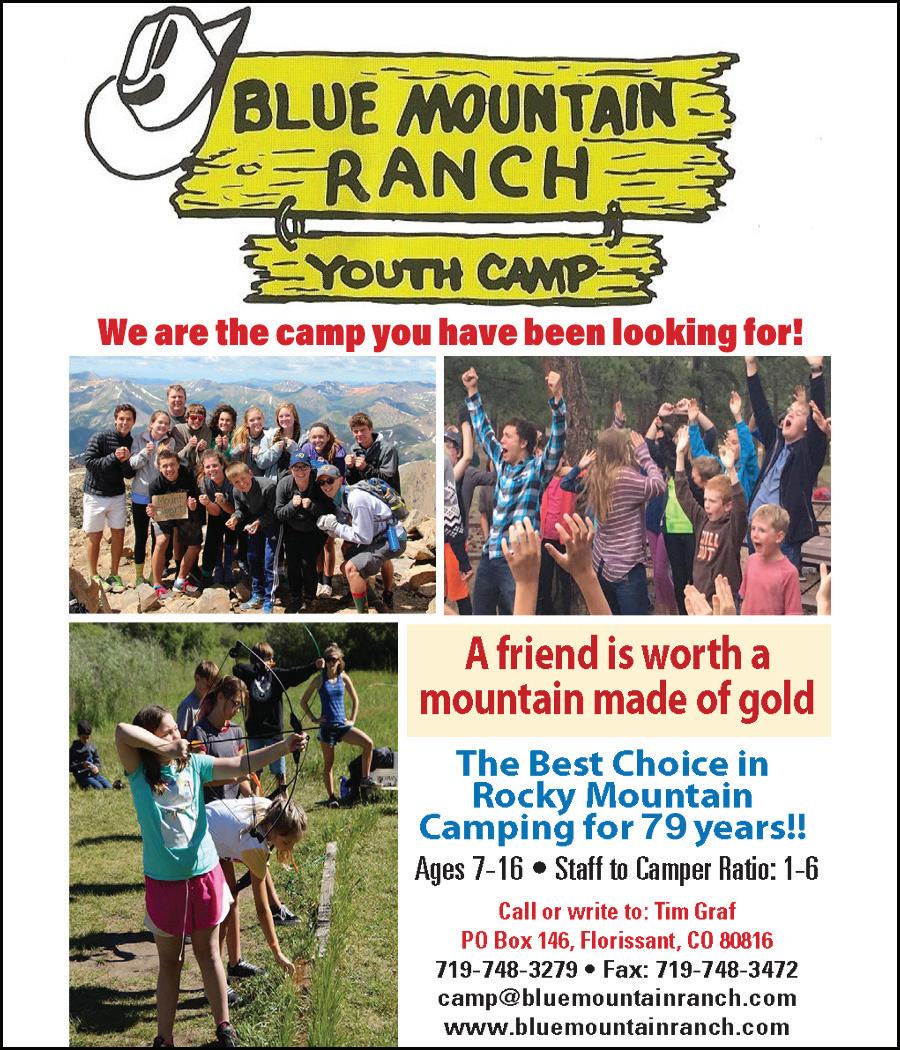





























Your burning Boulder questions on sex and romance, asked and answered
BY GABBY VERMEIRE
We all have questions and need advice, but sometimes the pseudo therapy in the Instagram stories of astrology girlies doesn’t cut it. Or maybe the gate-keeping culture of adventure bros has you fearing the judgment that comes with revealing yourself as a newbie at anything. This special Valentine’s Day edition of our monthly advice column exists to hold space for you and your Boulder queries on love (especially the uncool ones).
How many dates is distasteful for a polyamorous person to go on for V Day?
To say something is distasteful is to enter a moral judgement on it — and if we’re all consenting adults here, then theoretically the limit does not exist, even though you might get weird looks from the SALT bartender when your fourth date buys your fourth old-fashioned-and-appy of the day. Or, you could find a serious answer to this question in the Savage Love archives.
















Should I keep in contact with that one Boulder boy that moved to Utah?
All it took was his real nice smile and penchant for amateur outdoor photography and you were down bad. But now he’s graduated from CU and you’re regretting lending him your copy of Desert Solitaire because he’s gone Full Abbey and moved to the actual desert.


Regret lending that dog-eared copy of Desert Solitaire to the cute Boulder boy who moved to the actual desert? The kids are calling it going “Full Abbey.” Courtesy: Ballantine Books
1. DIRTY CHAI WITH OATMILK. Your partner is a Trident barista, the beanie stays on, and something about the way the light hits the soles of your feet when you do that thing inspires a poem in a Trident-published zine.
Something about the angst of this question tells me you are baby, and baby, life is long. Before you know it, the Pasta Jay’s in Moab will remind him of Boulder (and your cute face), and oh look, an entry-level coder position just opened up at his buddy’s startup in Boulder.
2. THE INTERMITTENT FAST. It’s been eight hours since either of you have eaten, with eight more to go. All you really need is a hit of dopamine and you might as well make each other feel good, even though you both know a donut would make you feel wayyy gooder. Per the name, you just gotta get there real fast.
What romantic gestures don’t feel cringey or corny? Is being in love inherently cringey and corny?
You could always try to retain your dignity by acting out corny gestures ironically: “Hey babe, I got you some ‘flowers’ from ‘King Soopers’ and then zhuzhed them up with some winter-browned sprigs from the trailhead that reminds of me our ‘first date’ to symbolize how our love exists both in the crass material plane but also in the private sphere of our own romantic imagination … Just kidding, haha, do you mind Venmo-ing me for dinner after you put these in a mason jar?”
But I also think dignity is overrated and that your vulnerability and open-heartedness shouldn’t give your person the ick, because remaining cool and falling in love are mutually exclusive.
3. THE STICKY PETE’S. It goes down in the Illegal Pete’s bathroom. You remember virtually nothing else, but in the morning you see that you and the bass player in a local jam band are now mutually following each other.
How do I completely rid myself of love and emotion?
Feelings are quite overrated, as is eating them in the form of dried mango as you wait for a response to that risky text (the risky text in question: “How do you feel about going to Portal, but like, together?”). I won’t give you some pop-psychology, empath-girly take about how feeling everything so much is actually a blessing No thank you, I’d rather be completely numb to the feeling I get from an incel


pride parade of men destroying everything good about the government.
If you’re serious about this, a cocktail of edibles, ketamine and Celsiuspowered ultra workouts cannot hold a candle to the ultimate “checking-out,” i.e. a lobotomy. Plus, terrible ideas from Kennedys are making a comeback.
What’s the most Boulder-ish V-Day date?
They really should have said “Boulder is for lovers,” because there is nothing like a place of overly permissive social norms and directionless striving to serve as the setting for you to be a simp and a clown, aka being in love. You could embody a classic Boulder archetype this Valentine’s Day by allowing your sense of self to be absorbed mind and body into your partner by misappropriating the Eastern religious practice of tantra. Or perhaps you and your partner are united by a mutual need to enter an anaerobic state. The weak, carnal creatures can have their tantra; you and bb are happy to shove yourselves into utterly sexless spandex bike bibs and spend a day where the only thing touching your butt is the seat of your Bianchi.
But you, you forgot what day falls on Feb. 14 (POW day, amirite brother?) and are now at Piece, Love & Chocolate 10 minutes before closing feeling like a schmuck. Can confirm, you are kind of a schmuck, and now there are five other guys in the same boat with only one slice of flourless chocolate cake left, and you are a gamma male at best. Do not despair: The superlative date is a grumpy sushi dinner in the Whole Foods parking lot followed by a surprise smooshed macaron that turns into pistachio-flavored kisses. Just like Boulder, it’s kinda messy but with a tasteful amount of sweetness — and like this analogy, it might make you nauseous.
Got a burning Boulder question? DM @wholefoods_daddy on Instagram or email letters@boulderweekly with the subject line “Dear Whole Foods Daddy.”
Cut out these Whole Foods Daddy V-Day cards for that special someone


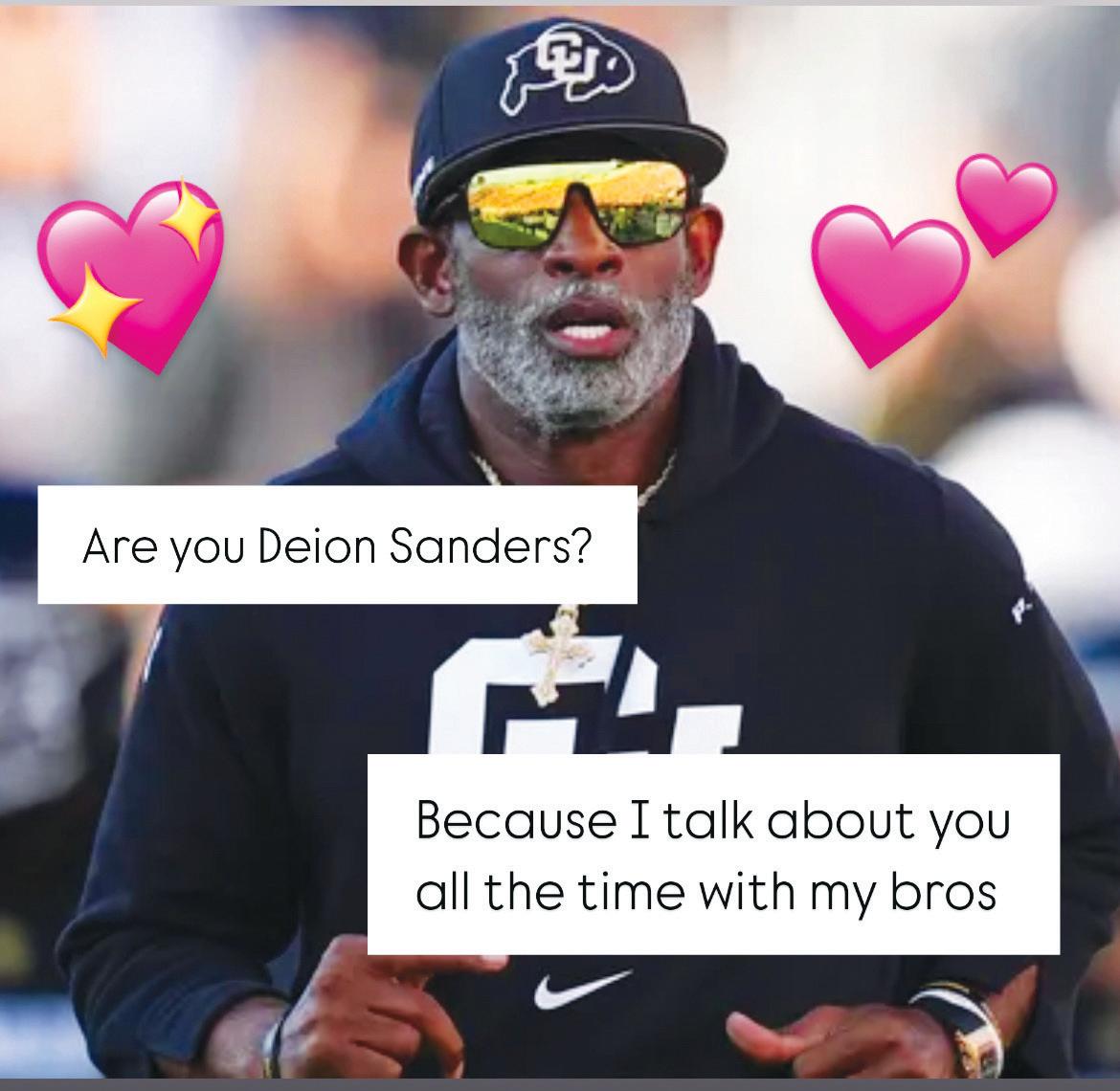


Big Richard make a meal of bluegrass stereotypes on ‘Girl Dinner’
BY JEZY J. GRAY
Put your keys between your fingers and make a fist. Stagger your feet and leverage your weight to escape a bear hug from behind. Be all ears, all eyes, all the time. Use any means necessary to make it back to your tour bus alive.
Self-defense isn’t part of the day-today calculus for most acts on the bluegrass festival circuit, but it was among the guidance offered to local quartet Big Richard by fellow all-women string band Della Mae in the early days of their career.
“It was really sweet and heartbreaking at the same time,” cellist Joy Adams tells Boulder Weekly on a video call with her bandmates ahead of their 2025 headlining national tour. “This is not a conversation bro bands would have.”
Big Richard have never done things quite like the boys — and on the traditional playing field of American roots music,
the bluegrass world” match their top-shelf musicianship with dick jokes and inflatable phalluses as they take aim at the conventions of genre and gender with impish glee.
“Historically, women in bluegrass sing songs about Jesus and play a very welldefined role,” Adams, 36, says. “To have four women come out on stage making horrible jokes, being aggressive and taking solos brings an attitude that has maybe been missing from roots music.”
The band may get a charge from sticking a thumb in the eye of expectation, but Longmont-based mandolin player and guitarist Bonnie Sims says the local Americana landscape is more welcoming of people who buck the standard.
nipple is illegal, then your nipple is illegal, buddy. Cover up. I don’t wanna see it.”
Of course, it takes more than a funny bone to build a following as devoted as Big Richard’s. Since first stepping on stage together at an invite-only Castle Rock festival in 2021, the Front Range supergroup have carved their sizeable reputation by dazzling audiences with a pyrotechnic live show, one gig at a time, shuffling barn-burner anthems with tender ballads and left-field covers of songs by the likes of Radiohead and Billie Eilish.
BIG RICHARD ENERGY: Scan the QR code for a BW exclusive Galentine’s Day playlist
“I grew up in a conservative bluegrass scene, and I would say all the [stereotypes] about bluegrass are true in that realm,” Sims, 38, says. “But Colorado bluegrass is not trad. This is a very progressive scene. When you go to a bluegrass festival in Texas, everybody tucks their T-shirts into their jeans.”
Now, on their just-released debut album Girl Dinner — recorded last year at Longmont’s Vermillion Road Studio — the band has captured the lightning of their live show in a bottle, even if it comes with a few less thunderclaps.



washing over the rest of the album’s 45-minute runtime like a gentle mountain stream.
“Everyone brings in their own songs, and we all collaborate on the arrangements,” says upright bassist and guitar player Hazel Royer, 23, currently studying at Berklee College of Music in Boston. “Sometimes people come in and they’re like, ‘I know exactly how everything’s gonna sound on my song,’ but most of the time that’s not how it goes.”
Poised on the precipice of the biggest moment in their career, Big Richard says the cross-country tour in support of their debut LP — stopping at Boulder Theater for a hometown show on Valentine’s Day — is more than an opportunity to grow in their craft while pissing off bluegrass gatekeepers. It’s a chance to connect with a broad swath of listeners who find something life-giving in the music.

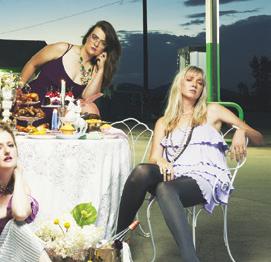


“We’ve played a lot of these songs so many times, and we’ve been working them into our live show,” says 32-yearold fiddle player Eve Panning. “But the energy is different, because in our live show we have these big, high-energy moments. We stepped away from that for this album and sort of focused on the softer side.”
Exceptions to the rule include fiery standouts like the fiddle-forward “Beards Brushing in the Night” and certified asskicker “Deal Me In,” showcasing the band’s formidable chops with a sizzling urgency. These livewire moments feel that much more charged against delicate blooms of cello and fluttering mandolin
“We went out to the merch table [at Sisters Folk Festival in Oregon] and there were 60-year-old women crying and hugging and us, like ‘I’ve never felt so free as when I watch you. Don’t ever stop what you’re doing, because this is really important,’” Sims says. “I think a lot of people are stirred up right now. It’s a climate thing. Having that intense emotional reaction is really powerful, and has made me be like, ‘Oh, I’m gonna dig in. I’m gonna go even harder.’”
On top of shining a light in the dark for the generations of women who came before them, Big Richard hope to serve as a model for little girls who might see themselves reflected onstage — larger than life, louder than hell and laughing like crazy.
“If I had been that age and had a band like this, I think it would have made a big difference in who I am as a person,” Adams says. “To see women be unapologetically themselves, that’s powerful in any field.”
ON THE BILL: Big Richard with Silas Herman & The Tone Unit and Heartthrob Hoedown. 8 p.m. Friday, Feb. 14, Boulder Theater, 2032 14th St. $32
‘Paddington in Peru’ is a sweet sentiment for a sour time
BY MICHAEL J. CASEY



Though he’s from the jungles of Peru, Paddington is British through and through. Sent to London by his kind and wise Aunt Lucy, the orphaned bear was adopted by the Brown family, named after the train station where they found him and inserted into a modern-day society that had forgotten its manners. Thankfully, Paddington mastered the “hard stare” and reminded anyone who crossed him and his loved ones that there were better choices to be made.
First published in the 1950s, Michael Bond’s Paddington books are children’s classics. My parents read them with me alongside The Many Adventures of Winnie-the-Pooh, The Berenstain Bears and Corduroy — bears were big in my household. The Paddington books are perfect for kids: hijinks and hilarity, morals and manners, and plenty of marmalade sandwiches.
That might sound light and frivolous, and when the first live-action adaptation came out in 2014, it was. But we’re a far cry from 2014, and the sweet sentiment at the heart of Paddington hits different in sour times.
The latest installment in the franchise, Paddington in Peru, reunites the majority of the cast from the first two movies, with Ben Whishaw reprising his vocal role of the marmalade-loving Paddington, Hugh Bonneville as the risk-averse insurance salesman Mr. Brown and Dame Julie Walters as the resourceful Mrs. Bird. Emily Mortimer replaces Sally Hawkins as Mrs. Brown (a fair trade).
Courtesy: Sony Pictures
Joining the caper is Olivia Coleman as the Reverend Mother in charge of Peru’s Home for Retired Bears — where Aunt Lucy (voiced by Imelda Staunton) resides — and Antonio Banderas as Hunter Cabot, an Amazonian tourist boat captain who agrees to take the Browns and Paddington up the river for less than altruistic reasons. There are two Brown children (Madeleine Harris and Samuel Joslin), and Cabot has a daughter (Carla Tous), but they’re mostly window-dressing.
Paddington in Peru feels a little overstuffed when it tries to find something for everyone to do, but it never gets too out
of hand. It’s an adventure story in the classic Saturday matinee sense, with Banderas and Coleman hamming it up as much as possible, particularly in the scenes where Cabot’s deceased ancestors goad him on.
The silliness might be off-putting to some, but it’s all in good fun. Dougal Wilson replaces Paul King in the director’s chair, and the movie loses a touch of whimsy — hallmarks of the first two installments. But Wilson, in his debut, brings enough frothy comedy alongside Whishaw’s indelible vocal performance as the titular bear. I don’t think I’ll ever be able to read one of Bond’s books again without hearing Whishaw’s voice in my head.
But what makes Paddington in Peru salient is the world in which we watch it.
Here is a story about an immigrant finding home in another land and family in the charity of adoption. The call of ancestry might pull Paddington back to the jungles of Peru, but it’s also where he discovers that just because you are from somewhere doesn’t necessarily mean that’s where you belong.
There’s an early scene in the movie where Paddington receives his British passport. The neighbors and the Browns gather to watch him open the envelope and celebrate. When Mr. Gruber (Jim Broadbent) hears of the official document, he congratulates Paddington: “You’re a real British citizen now!”
Yes, I know I’m watching a digital bear, and I know that this embrace of refugees is not a current reality in London — and certainly not in the country I call home — but these are the moments that move me. It’s a reminder that at one point, no matter how fleeting, this was true. And maybe, someday, it will be again.
Who knows? Maybe the kid watching Paddington in Peru today won’t grow up to be a film critic for a weekly newspaper, but a crusader who will fight for the rights of others because, as Paddington says: “If we’re kind and polite, the world will be right.” One can always hope.
ON SCREEN: Paddington in Peru opens in theaters Feb. 14.
Sendak gets the gallery treatment in meditative Denver Art Museum exhibition
BY PARKER YAMASAKI
It starts with a young boy in his room.
Max slams his door and gets sent to bed with no dinner.
Mickey hears a late-night racket and falls into a vat of batter.
Kenny wakes up from a prophetic dream.
It’s no coincidence that so many of Maurice Sendak’s beloved books — Where the Wild Things Are, In the Night Kitchen, Kenny’s Window — begin in the bedroom during the odd and deep hours of the night. It’s the time when life falls away and parents are distracted, when darkness descends and the imagination loosens up. The time when the things that go bump in the night go bump.
An outgoing exhibition running through Feb. 17 at the Denver Art Museum (DAM), Wild Things: The Art of Maurice Sendak, pays tribute to the man who never considered himself a children’s book author, but nonetheless won every prize imaginable for his children’s books. The show boasts more than 450 objects and artworks, tracing a rich creative life that extends far beyond his 1963 masterpiece
Co-organized by the Columbus Museum of Art in partnership with The Maurice Sendak Foundation, the DAM exhibition is wholesome and filled to the brim with nostalgia; but it’s also dark, meditative and absolutely wild.
Sendak ticked away many of his own early days stuck in bed, riddled with illnesses that often separated him from the rest of the world. He was also a dreamer. He could quickly tap into the unreality of fantastic worlds— not quite lovely, not quite nightmarish — and translate those complex qualities onto the page.
That sort of everything, all at once logic is the logic of childhood, and Sendak’s lasting legacy is found in his lucid depictions of kid characters. His Maxes and Rosies and Pierres are charming, daring and joyful; they’re also bratty little bullies sometimes. They get yelled at by their parents and they boss around their friends. So many children’s books show kids who they can be, littered with lessons and morals. Sendak’s books show kids who they are.
Even though Sendak’s career is forever entwined with the success of Where the Wild Things Are, the museum doesn’t let that interfere with his prolific creativity. His whimsical processes and generous love for collaborators are on full display in the DAM exhibition. Sendak’s “fantasy sketches” adorn the walls, single sheets of paper where he improvised storylines while listening to a piece of music, typical-

ly classical. He sketched to Beethoven, Schubert and Mozart. He revered Mozart, calling him his god.
Born in 1928, Sendak grew up in a Polish-Jewish household in Brooklyn. Although he deeply identified with the culture of Judaism, Sendak remained secular throughout his life. His personal pantheon also included Herman Melville and Emily Dickinson.

He grappled with the darkest aspects of humanity from a young age. Sendak’s childhood was spent in close proximity to tragedy, with several members of his extended family dying in the Holocaust.
“I remember my own childhood vividly. I knew terrible things,” Sendak says in a 1993 New Yorker interview with Art Spiegelman. “But I musn’t let the adults know I knew … It would scare them.”
While biographical details can sometimes bog down an exhibition, the elements selected by co-curators
Jonathan Weinberg and Christoph Heinrich illuminate Sendak with new clarity, revealing the man’s contours without overshadowing his work. He collected Mickey Mouse memorabilia and had a thing for the German romantics. He loved cake; he loved dogs; he loved his partner, Eugene David Glenn, whom he met in the 1950s and spent his life with. Wild Things also pays heavy homage to Sendak’s many collaborators, including Ruth Krauss, Carole King, Spike Jonze, Tony Kushner and Dave Eggers.
Some of Sendak’s first successes were alongside Krauss, a popular children’s book author who had a massive influence on Sendak’s career — not just commercially, but in style and semantics. Her beatnicky writing freed Sendak to illustrate sentences like:
“Mud is to jump in and slide in and yell doodleedoodleedoo,” which appears in their 1952 book, A Hole is to Dig. She also encouraged Sendak to try new techniques with every book to avoid becoming boring, advice he took to heart. He rarely repeated himself and worked in a variety of artistic styles. When people clamored for a Where the Wild Things Are sequel, he’d tell them to go to hell.

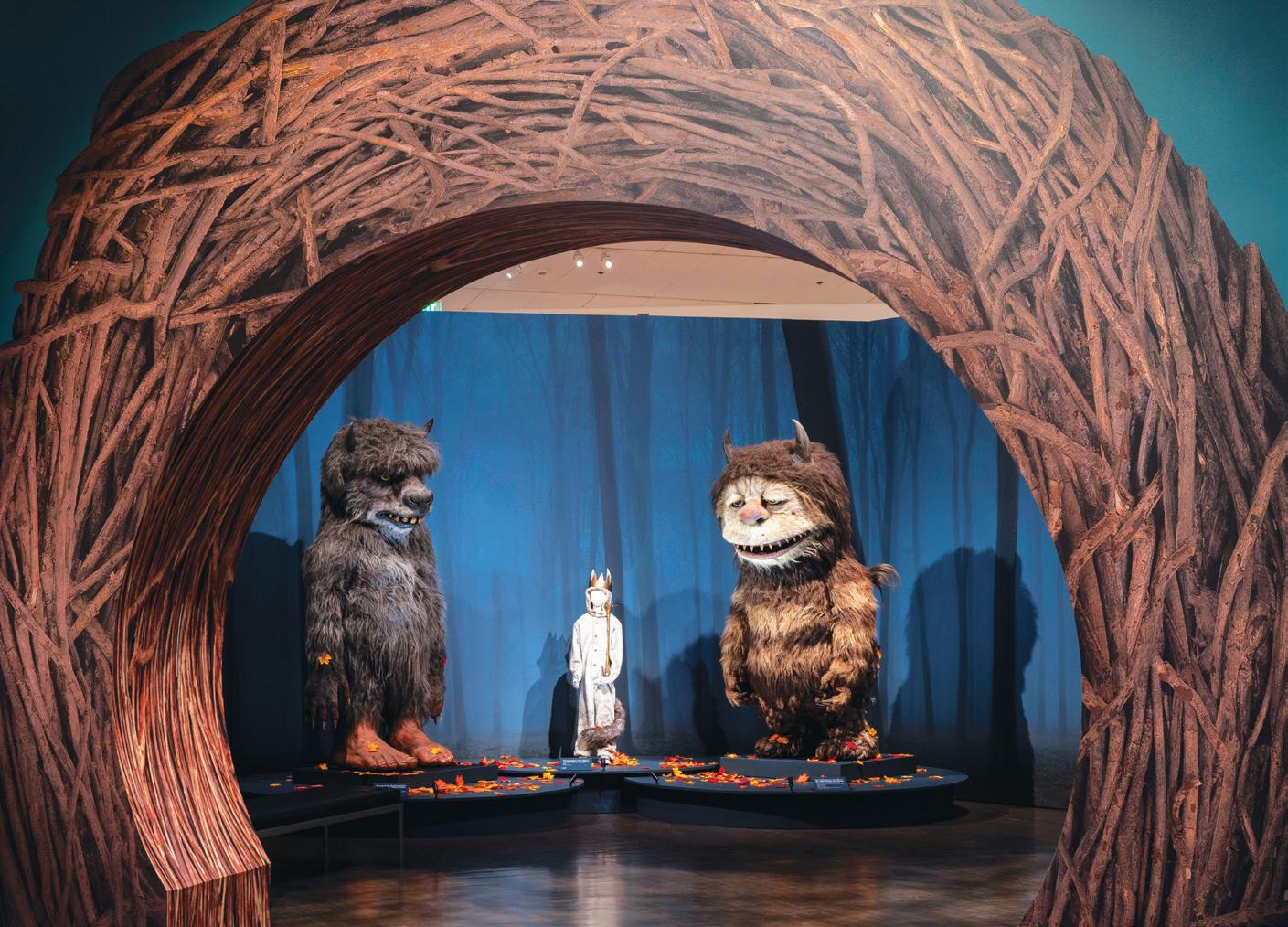
The natural centerpiece of the exhibition is the Wild Things room, a hushed space with dark teal walls. While other areas of the exhibition are layered with sketches, notes and ephemera, here the display is sparse, featuring only the original paintings for Where the Wild Things Are in the order they appear in the book. The shape of the room guides visitors from left to right, taking in each panel as if reading. Sendak was approached with all kinds of deals for the wild things. They appeared on New York book fair posters, in a Bell Atlantic campaign, in the Macy’s Thanksgiving Day Parade, in an opera.
Almost half a century after the book was published, Sendak finally agreed to a movie directed by Spike Jonze in 2009, just a few years before the author’s death at age 83.
He had turned down a number of proposals by then, but Jonze presented a vision for the movie aligning with Sendak’s sensibility that children could handle the darker aspects of the world.
The one thing Sendak didn’t completely agree with was how the movie should depict the transition between Max’s bedroom and the fantastical world of the wild things. In the book, trees start to sprout from the bedroom floor, and gradually the
room itself is transformed. But in film, everything that happens thereafter would be too obviously understood as a dream.
“There’s nothing worse than a movie that is all in somebody’s head or a dream,” Dave Eggers, co-writer for the screenplay, explains in the museum’s audio tour of the exhibition.
After much explanation, Sendak relented. The boy would have to leave the room.
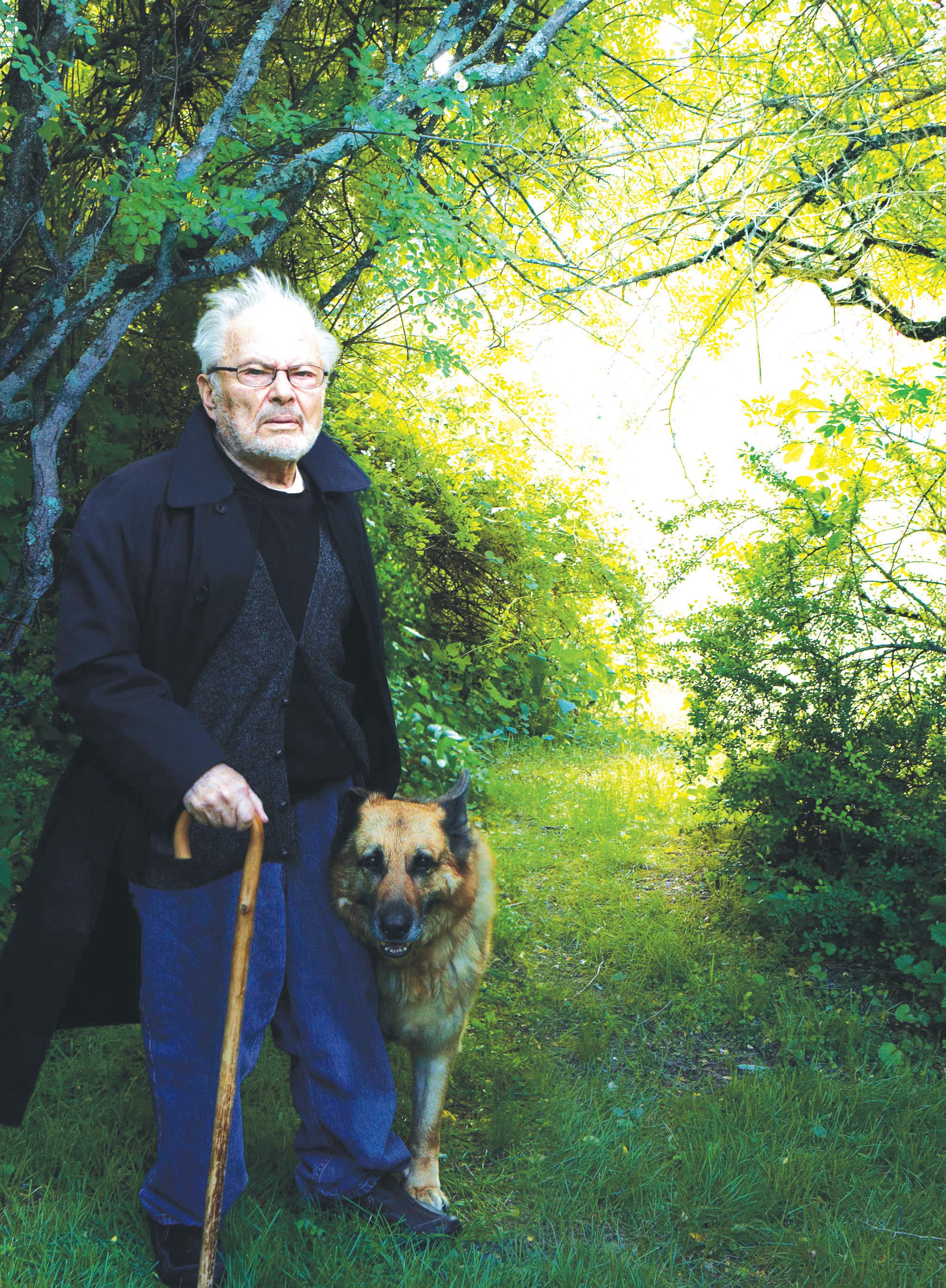


14
WHISKY & A SWEET TREAT
11 a.m. to 9 p.m. Friday, Feb. 14, Spirit Hound Lyons, 4196 Ute Highway. $20

WINTER BIKE TO WORK DAY
10 a.m. to 6 p.m. Thursday, Feb. 13 and 10 a.m. to 4:30 p.m. Friday, Feb. 14, The New Local Annex, 713 Pearl St. Free
Love is in the air at The New Local, Boulder’s women-run arts nonprofit on West Pearl Street. Swing by for a special two-day Valentine’s blowout at The Annex featuring floral arrangements from Fawns Leap, goodies from Moksha Chocolate and jewelry from Blackbird and the Snow — plus ceramic flower vessels, beaded jewelry and more.

9 a.m. to 7 p.m. Thurs.-Sat., Feb. 13-15, 9 a.m. to 2 p.m. Sunday, Feb. 16, Boulder County Fairgrounds, 9595 Nelson Road, Longmont. Free
Kids grow fast, so why spend a fortune on clothes and shoes? Shop this massive, four-day pop-up sale of gently used, locally sourced discount items for all your kiddos, from babies to teens. Prices are 50-90% lower than retail. Tickets required: longmont.jbfsale.com.
Show yourself some love this Valentine’s Day and indulge in some sweet whisky and a sweeter treat. At Spirit Hound in Lyons, choose any cocktail and pair it with chocolatey, nutty baked goods from the beloved Moxie Bread Co. Go ahead and get a double pour, you deserve it. Tickets: bit.ly/SpiritHoundBW.

14
VALENTINE POP-UP
3-5 p.m. Friday, Feb. 14, Few of a Kind Vintage + Mercantile, 124 2nd Ave., Niwot. Free
Pick out something special for your sweetie at this Valentine’s Day market featuring everything from Louis Sherry chocolate truffles in keepsake tins to locally made jewelry. Or better yet, craft a bouquet yourself at the tulip bar from Slupik MiniFarm. If DIY isn’t your thing, preorder a professional arrangement for $40: bit.ly/ValentinePopupBW.
7-9 a.m. Friday, Feb. 14, breakfast stations across Boulder County. Free
Hop on your bike and brave the elements for this annual event for old and new cyclists across the globe. Stations across Boulder, Longmont, Lafayette, Louisville and Erie will be serving up free breakfast and camaraderie to lift your spirits before the office slog. Workfrom-homers welcome. Find a map of breakfast stations at bit.ly/ Bike2WorkBW.

TROMEO & JULIET: A VERY TROMATIC VALENTINE’S DAY
8:30 p.m. Friday, Feb. 14, and 5 p.m. Saturday, Feb. 15, Dairy Arts Center, 2590 Walnut St., Boulder. $12
Your V Day plans just got freakier. Join local author and filmmaker Mathew Klickstein for a two-day screening of Tromeo & Juliet, a completely out-ofpocket retelling of the Bard’s classic from B-movie juggernaut Troma Entertainment. The subversive production company’s co-founder Lloyd Kaufman will attend virtually on Feb. 15 for a post-film Q&A. Read more at bit.ly/ TromeoBW.

9:30 a.m. to 2:30 p.m. Saturday, Feb. 15, TinkerMill, 1840 Delaware Place Unit A, Longmont. Free ($15 donation suggested)
Save the planet and your stuff by repairing that busted laptop, toy or trinket instead of tossing it in the trash. Expert Tinkerers will be on hand to help teach you to rehab your precious items. Got a knack for fixing things? Email info@tinkermill.org to volunteer your time and skills.

9 a.m. to noon, Saturday, Feb. 15, Brainard Lake Road, Ward. $82
Who said Galentine’s had to be at a wine bar? Grab the girls and strap on your snowshoes for a four mile hike into the Indian Peaks backcountry with an experienced trek leader from Colorado Wilderness Rides and Guides. Snowshoes will be provided — and don’t worry, so are the warm drinks. bit.ly/ GalsSnowshoeBW.

All day Monday, Feb. 17, Erie Ice Rink, 575 Kattell St. $10
Get creative at this totally ~cool~ all ages event that will turn the Erie Ice Rink into a community art project. The registration price covers a 4’ by 4’ square on the ice plus all the supplies you’ll need — share it with a group or make your square a solo masterpiece.
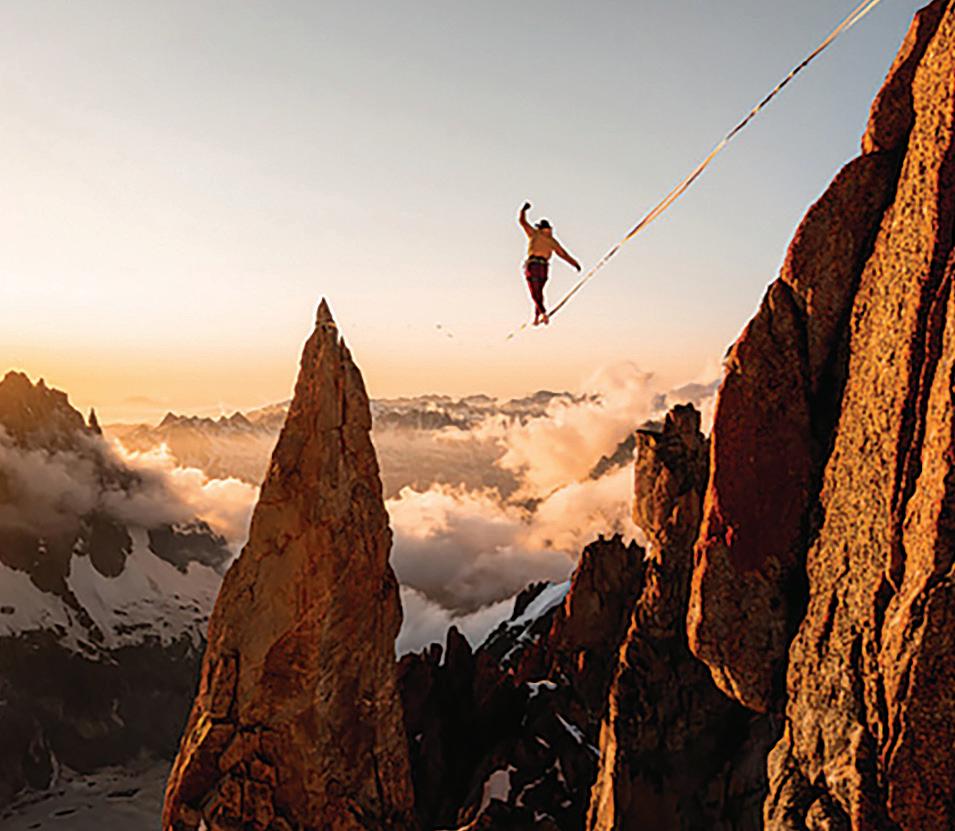
6-9 p.m. Monday, Feb. 17 to Wednesday, Feb. 19, Boulder Theater, 2040 14th St. $38+
Explore the snowiest peaks, steepest crags and wildest backcountry terrain on the silver screen during this threeday cinematic exposition of adventure films. This lineup of more than 20 films will take you to the ends of the Earth and bring you untold stories from the world’s most hardcore adrenaline junkies.
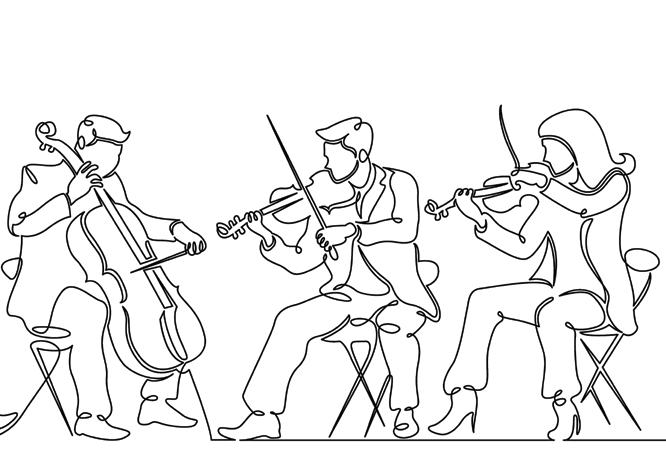
6:30 p.m. Wednesday, Feb. 19, Dickens Opera House, 302 Main St., Longmont. $25
Join the Boulder Philharmonic Orchestra for their last performance of the season’s Shift series. Musicians blend gospel, jazz, blues, bluegrass, country and global folk to reimagine Americana music by including all the diverse cultures that make up our country. “Dancing, hoots and hollers are not just allowed but encouraged!”

5-8 p.m. Thursday, Feb. 20, The Backdoor Theatre, 750 Colorado 72, Nederland. $5
Come see what makes the great outdoors so great during the 20th annual Backcountry Film Festival. Presented by Winter Wildlands Alliance, this anticipated community event in Ned “celebrates the power and spirit of humans in winter” with a collection of films selected from more than 320 submissions.



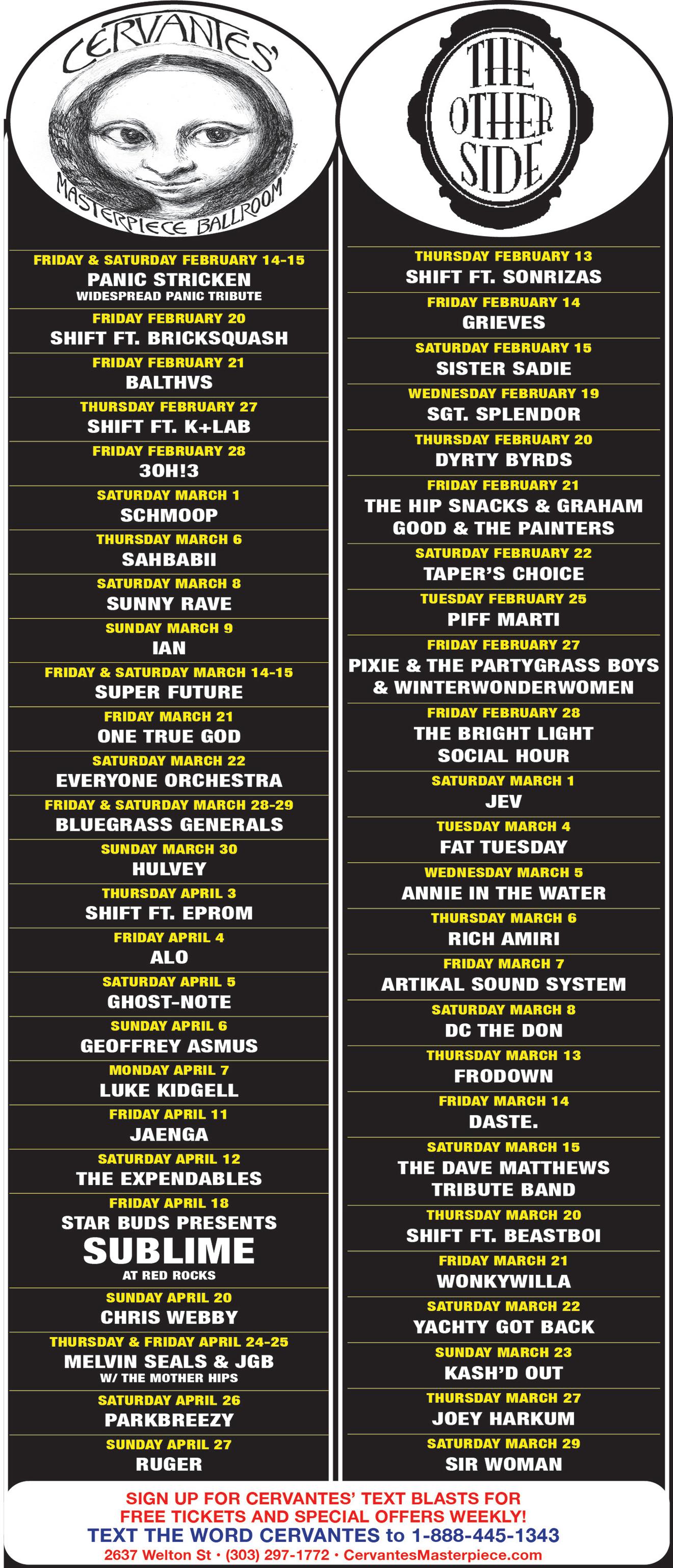
THURSDAY, FEB. 13
OONIE KOONIE CHA SONG FESTIVAL 5 p.m. Boulder Public Library, 1001 Arapahoe Ave., Boulder. Free
DAN HOCHMAN WITH ARI MELINGER-COHEN 6 p.m. Stone Cottage Studios, 1928 Pearl St., Boulder. $65 (includes food and drink)
TRIBONACCI TRIO 6 p.m. Bricks on Main, 471 Main St., Longmont. Free
JT JONES AND DAN FROELICH. 6 p.m. Bootstrap Brewing Company, 142 Pratt St., Longmont. Free
CANDLELIGHT: COLDPLAY & IMAGINE DRAGONS. 6:15 p.m. eTown Hall, 1535 Spruce St., Boulder. $27
CIRCLE SINGING WITH CREATIVITY ALIVE AND ROY WILEY 7 p.m. First United Methodist, 1421 Spruce St., Boulder. $25
STEPHEN BROOKS QUARTET 7 p.m. Nissi’s, 1455 Coal Creek Drive, Unit T, Lafayette. Free
DANNY SHAFER WITH JEREMY DION 7 p.m. The Times Collaborative, 338 Main St., Longmont. $18
LATINSOUL VALENTINE’S DANCE PARTY 7:30 p.m. Roots Music Project, 4747 Pearl St., Suite V3A, Boulder. $18
CANDLELIGHT: TRIBUTE TO QUEEN. 8:15 p.m. eTown Hall, 1535 Spruce St., Boulder. $31
PANIC STRICKEN 8 p.m. Fox Theatre, 1135 13th St., Boulder. $36
FRIDAY, FEB. 14
OPUS TWO - LOVE & SONDHEIM. 2:30 p.m. Longmont Museum, 400 Quail Road. $12
ONE LOVE, ONE JOY WITH TUBBY LOVE, PAUL IZAK, ANDY BABB AND LARA ELLE 5:30 p.m. Avalon Ballroom, 6185 Arapahoe Road, Boulder. $37
WEST HWY 7 BAND 6 p.m. Bootstrap Brewing Company, 142 Pratt St., Longmont. Free
JOE COOL BAND. 6 p.m. Bricks on Main, 471 Main St., Longmont. Free
THE VELVETEERS WITH CHERRY SPIT AND DIVA CUP Hi-Dive, 7 South Broadway, Denver. $20. Sold out. bit.ly/VelveteersBW
PAULA GAYATRI WITH MIRA DEVI. 6 p.m. Trident Cafe, 940 Pearl St., Boulder. Free
VALENTINE’S DAY TRIBUTE TO NORAH JONES 6;30 p.m. Roots Music Project, 4747 Pearl St., Suite V3A, Boulder. $30
BALLYHOO! WITH SERENATION AND THE HARBOR BOYS. 7 p.m. Fox Theatre, 1135 13th St., Boulder. $27
DANIEL RODRIGUEZ BAND. 7 p.m. The Caribou Room, 55 Indian Peaks Drive, Nederland. $22
JESÚS CASTRO-BALBI. 7:30 p.m. Chamber Hall, 1020 18th St., Boulder. Free
TINSLEY ELLIS 8 p.m. Velvet Elk Lounge, 2037 13th St., Boulder. $29
BIG RICHARD WITH SILAS HERMAN AND THE TONE UNIT 8 p.m. Boulder Theater, 2032 14th St. $32. STORY ON P. 16
ALPHATONES. 9 p.m. Mountain Sun Pub, 1535 Pearl St., Boulder. Free
A VERY EMO VALENTINE’S DAY. 10 p.m. Bounce Empire, 1380 S. Public Road, Lafayette. $34
LARAAJI WITH GI GI, FOANS AND MAAM. 7 p.m. Aztlan Theatre, 974 Santa Fe Drive. $38 / $111 double date special. BW PICK OF THE WEEK
SATURDAY, FEB. 15
AUDIOMEDZ 6 p.m. Bricks on Main, 471 Main St., Longmont. Free
10 YEAR ECHO 6 p.m. Bootstrap Brewing Company, 142 Pratt St., Longmont. Free
KOBER & SITERO (OF HIGH LONESOME). 7 p.m. Helios Public Art House, 364 Main St., Longmont. $15 (suggested cover)
DAVE ABEAR’S A VERY JERRY BAND 7 p.m. The Riverside, 1724 Broadway, Boulder. $15
A NIGHT OF OPERA FAVORITES WITH BOULDER OPERA COMPANY. 7:30 p.m. Broomfield Auditorium, 3 Community Park Road. $7+

New-age ambient music legend Laraaji takes the stage at Denver’s Aztlan Theatre for a special Valentine’s Day performance with Austin, Texas-based producer Gi Gi alongside locals FOANS and MAAM. Featuring breathwork and movement led by George Delaney, this transcendent multi-sensory experience presented by KGNU is the first in a series to support the historic theater, “which is in danger of being lost forever,” according to the official event listing. Scan the QR code for a GoFundMe link to support the historic venue. See listing for details
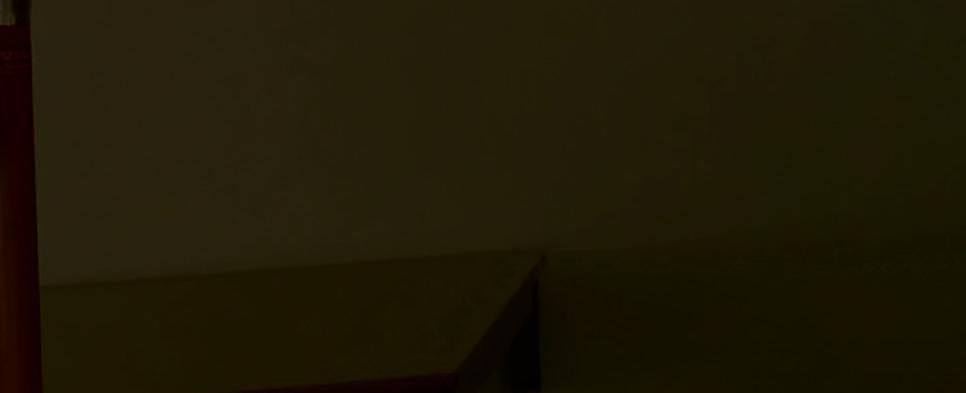
LUKA BULLA 8 p.m. Chautauqua Community House, 301 Morning Glory Drive, Boulder. $24
FOGGY MOUNTAIN SPACESHIP DUO 8 p.m. Longs Peak Pub, 600 Longs Peak Ave., Longmont. Free
AL’S HWY 50 WITH BATHING LAGOON 8 p.m. Velvet Elk Lounge, 2037 13th St., Boulder. $20
UNCLE ACID & THE DEADBEATS WITH JONATHAN HULTÉN. 8 p.m. Boulder Theater, 2032 14th St. $47
FULTON LEE 8 p.m. Fox Theatre, 1135 13th St., Boulder. $25
BIG PINCH WITH SURPRISE SOUP AND MIND GARDENS. 8 p.m. Hi-Dive, 7 S. Broadway, Denver. $12
POLDOORE WITH BORAHM LEE AND ELIPTEK. 9 p.m. Roots Music Project, 4747 Pearl St., Suite V3A, Boulder. $24
SUNDAY, FEB. 16
LAURIE D 2 p.m. Busey Brews, 70 E. 1st St., Nederland. Free
LOCO UKULELE JAM. 2 p.m. Bootstrap Brewing Company, 142 Pratt St., Longmont. Free
SHAWN CUNNANE 4 p.m. Left Hand Brewing, 1265 Boston Ave., Longmont. Free
FOXFEATHER 5 p.m. Bricks on Main, 471 Main St., Longmont. Free


FACE VOCAL BAND - DATE NIGHT WITH FACE! 7 p.m. Roots Music Project, 4747 Pearl St., Suite V3A, Boulder. $40
HIPPO CAMPUS WITH MEI SEMONES 8 p.m. Mission Ballroom, 4242 Wynkoop St., Denver. $55
MONDAY, FEB. 17
MUSIC BINGO. 6:30 p.m. Johnson’s Station, 1111 Neon Forest Circle, Longmont. Free
GOVOROV WITH DE GROOT DUO.
7:30 p.m. Chamber Hall, 1020 18th St., Boulder. Free
TUESDAY, FEB. 18
CHUCK SITERO WITH DAVID LAWRENCE. 5:30 p.m. Spirit Hound Distillers, 4196 Ute Hwy., Lyons. Free
WEDNESDAY, FEB. 19
FOGGY TOP BLUEGRASS BAND
6 p.m. Rosalee’s Pizzeria, 461 Main St., Longmont. Free
AMERICANA: REDEFINED WITH BOULDER PHILHARMONIC
ORCHESTRA. 6:30 p.m. Dickens Opera House, 300 Main St., Longmont. $10





Want more Boulder County events? Check out the complete listings online by scanning this QR code.


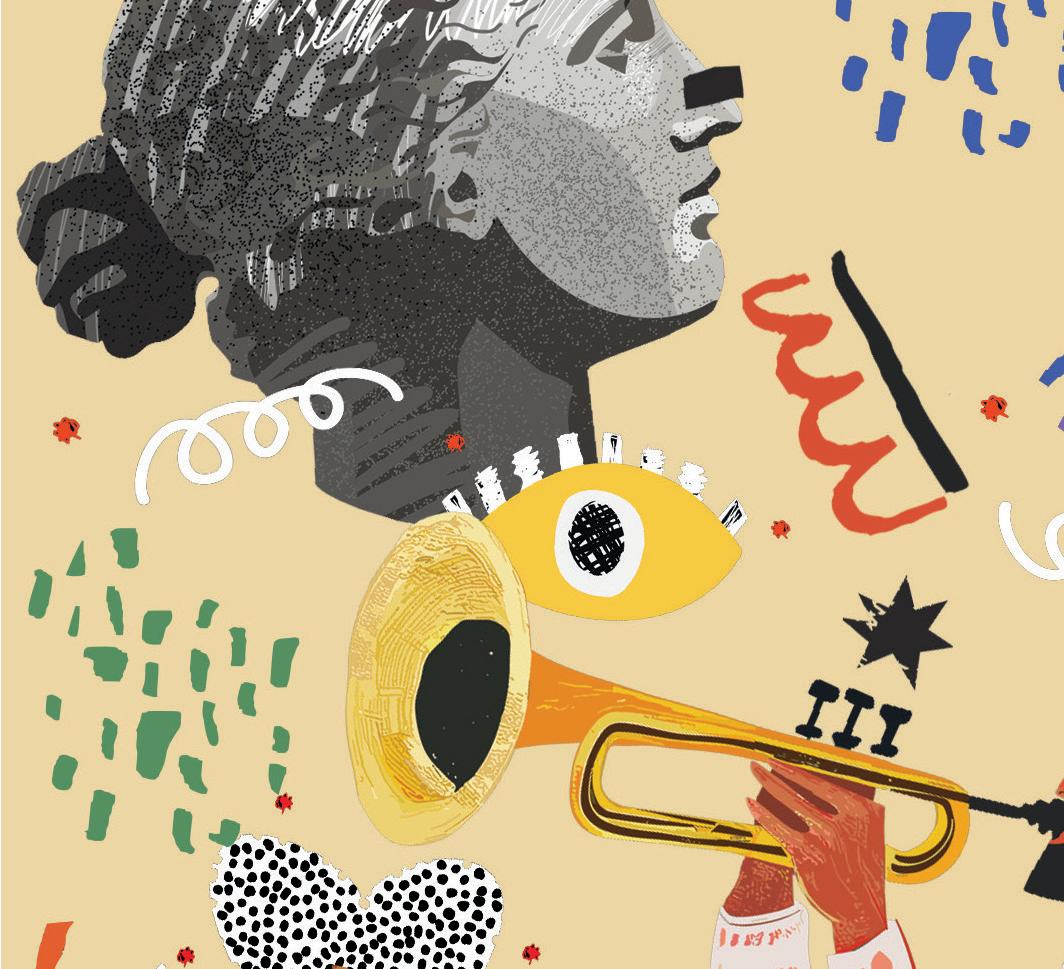
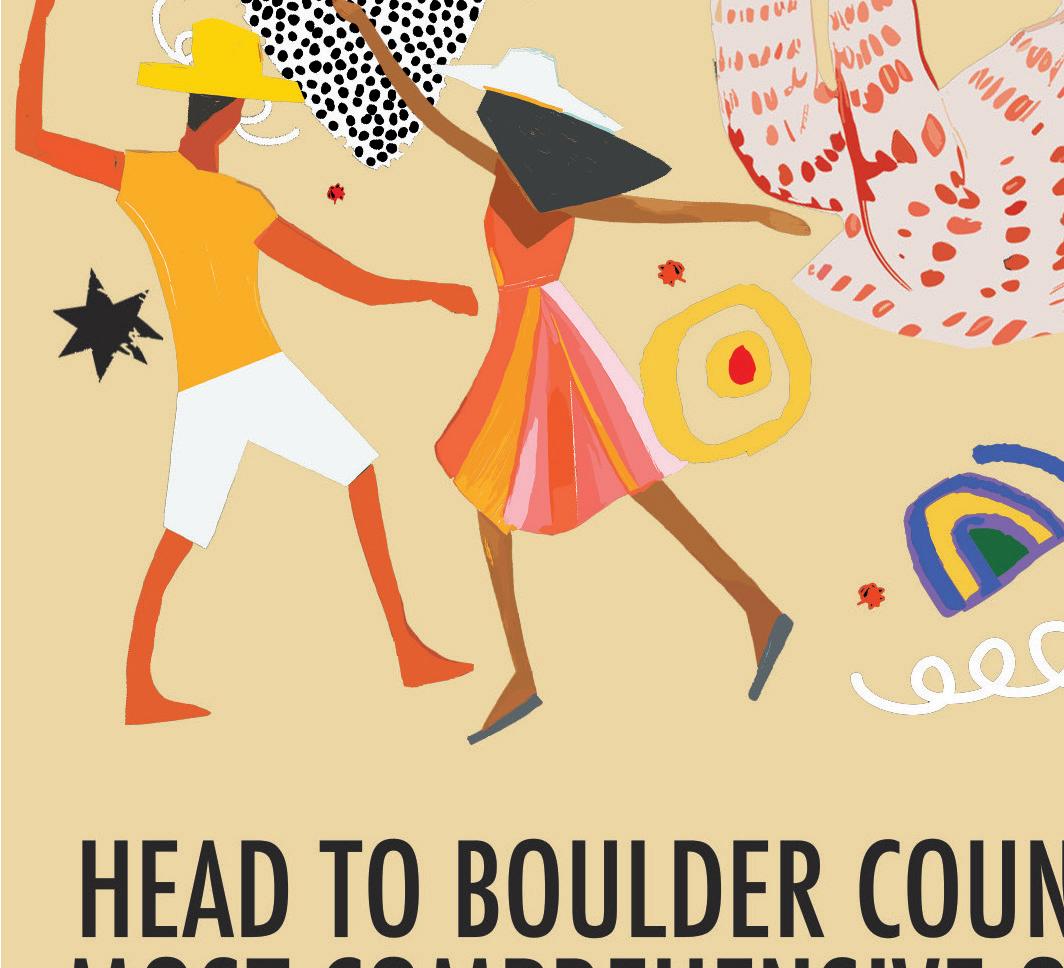

BY ROB BREZSNY
ARIES (MARCH 21-APRIL 19): Love requires stability and steadiness to thrive. But it also needs unpredictability and imaginativeness. The same with friendship. Without creative touches and departures from routine, even strong alliances can atrophy into mere sentiment and boring dutifulness. With this in mind, and in accordance with astrological omens, I offer quotes to inspire your quest to keep togetherness fertile and flourishing. 1. “Love has no rules except those we invent, moment by moment.” –Anaïs Nin. 2. “The essence of love is invention. Lovers should always dream and create their own world.” – Jorge Luis Borges. 3. “A successful relationship requires falling in love many times, always with the same person, but never in quite the same way.” – Mignon McLaughlin.
TAURUS (APRIL 20-MAY 20): In celebration of the Valentine season, I suggest you get blithely unshackled in your approach to love. Be loose, limber and playful. To stimulate the romantic and intimate qualities I think you should emphasize, I offer you these quotes: 1. “Love is the endless apprenticeship of two souls daring to be both sanctuary and storm for one another.” – Rainer Maria Rilke 2. “Love is the revolution in which we dismantle the prisons of our fear, building a world where our truths can stand naked and unashamed.” – Audre Lorde. 3. “Love is the rebellion that tears down walls within and between us, making room for the unruly beauty of our shared becoming.” – Adrienne Rich.
GEMINI (MAY 21-JUNE 20): To honor the rowdy Valentine spirit, I invite you to either use the following passage or compose one like it, then offer it to a willing recipient who would love to go deeper with you: “Be my thunderclap, my cascade of shooting stars. Be my echo across the valley, my rebel hymn, my riddle with no answer. Be my just-before-youwake-up-dream. Be my tectonic shift. Be my black pearl, my vacation from gloom and doom, my forbidden dance. Be my river-song in F major, my wild-eyed prophet, my moonlit debate, my infinite possibility. Be my trembling, blooming, spiraling and soaring.”
CANCER (JUNE 21-JULY 22): Cancerian author Elizabeth Gilbert wrote, “The universe buries strange jewels deep within us all.” One of those strange jewels in you is emerging from its hiding place. Any day now, it will reveal at least some of its spectacular beauty — to be followed by more in the subsequent weeks. Are you ready to be surprised by your secret self? Are your beloved allies ready? A bloom this magnificent could require adjustments. You and yours may have to expand your horizons together.
LEO (JULY 23-AUG. 22): In 2025, the role that togetherness plays in your life will inspire you to achieve unexpected personal accomplishments. Companionship and alliances may even stir up destiny-changing developments. To get you primed, I offer these quotes: 1. “Love is a trick that nature plays on us to achieve the impossible.” – William Somerset Maugham. 2. “Love is the ultimate outlaw. It won’t adhere to any rules. The most any of us can do is sign on as its accomplice.” – Tom Robbins. 3. “Whatever our souls are made of, his and mine are the same. Yet each day reveals new constellations in our shared sky.” – Emily Brontë.
VIRGO (AUG. 23-SEPT. 22): Psychotherapist Robin Norwood wrote that some people, mostly women, give too much love and kindness. They neglect their own self-care as they attend generously to the needs of others. They may even provide nurturing and support to those who don’t appreciate it or return the favor. Author Anne Morrow Lindbergh expressed a different perspective. She wrote, “No one has ever loved anyone too much. We just haven’t learned yet how to love enough.” What’s your position on this issue, Virgo? It’s time for you to come to a new understanding of exactly how much giving is correct for you.
LIBRA (SEPT. 23-OCT. 22): Are you ready to express your affection with lush and lavish exuberance? I hope so. Now would be an excellent time, astrologically speaking. I dare you to give the following words, composed by poet Pablo Neruda, to a person who will be receptive to them. “You are the keeper of my wildest storms, the green shoot splitting the stone of my silence. Your love wraps me in galaxies, crowns me with the salt of the sea, and fills my lungs with the language of the earth. You are the voice of the rivers, the crest of the waves, the pulse of the stars. With every word you speak, you unweave my solitude and knit me into eternity.”
SCORPIO (OCT. 23-NOV. 21): Among its potential gifts, astrology can raise our awareness of the cyclical nature of life. When used well, it helps us know when there are favorable times to enhance and upgrade specific areas of our lives. For example, in the coming weeks, you Scorpios could make progress on building a strong foundation for the future of love. You will rouse sweet fortune for yourself and those you care for if you infuse your best relationships with extra steadiness and stability.
SAGITTARIUS (NOV. 22-DEC. 21): I want you to be moved by intimacy and friendships that buoy your soul, inspire your expansive mind and pique your sense of adventure. To boost the likelihood they will flow your way in abundance during the coming weeks, I offer you these quotes. 1. “Love is a madness so discreet that we carry its delicious wounds for a lifetime as if they were precious gems.” – Federico García Lorca. 2. “Love is not a vacation from life. It’s a parallel universe where everything ordinary becomes extraordinary.” – Anne Morrow Lindbergh. 3. “Where there is love there is life. And where there is life, there is mischief in the making.” – my Sagittarius friend Artemisia.
CAPRICORN (DEC. 22-JAN. 19): Every intimate alliance is unique, has its own rules and shouldn’t be compared to any standard. This is a key theme for you to embrace right now. Below are helpful quotes. 1. “Each couple’s love story is a language only they can speak, with words only they can define.” –Federico Fellini. 2. “In every true marriage, each serves as guide and companion to the other toward a shared enlightenment that no one else could possibly share.” – Joseph Campbell. 3. “The beauty of marriage is not in its uniformity but in how each couple writes their own story, following no map but the one they draw together.” – Isabel Allende. 4. “Marriages are like fingerprints; each one is different, and each one is beautiful.” – Maggie Reyes.
AQUARIUS (JAN. 20-FEB. 18): Borrowing the words of Aquarian author Virginia Woolf, I’ve prepared a love note for you to use as your own. Feel free to give these words to the person whose destiny needs to be woven more closely together with yours. “You are the tide that sweeps through the corridors of my mind, a wild rhythm that fills my empty spaces with the echo of eternity. You are the unspoken sentence in my every thought, the shadow and the light interwoven in the fabric of my being. You are the pulse of the universe pressing against my skin, the quiet chaos of love that refuses to be named. You are my uncharted shore.”
PISCES (FEB. 19-MARCH 20): Love and intimacy and togetherness are fun, yes. But they’re also hard work — especially if you want to make the fun last. This will be your specialty in the coming months. I’ve assembled four quotes to inspire you. 1. “The essence of marriage is not that it provides a happy ending, but that it provides a promising beginning — and then you keep beginning again, day after day.” –Gabriel García Márquez. 2. “The secret of a happy marriage remains a secret. But those who follow the art of creating it day after day come closest to discovering it.” – Pearl Buck. 3. “Love is a continuous act of forgiveness.” – Maya Angelou. 4. “In the best of relationships, daily rebuilding is a mutual process. Each partner helps the other grow.” – Virginia Satir
I’m a newly-out gay man who is also exploring kink and leather for the first time. It has been fun, especially because I love daddies, and some wonderful older men have been my guides to this brave new world of rubber and slings. However, a few have ghosted me because I end up texting too much due to the fact that I’m worried they’re losing interest. I’m realizing this is a red flag to others. I’m needy but it’s rooted in the fact that this is all new to me. And since I feel late to the party, I need to move things along quickly to make up for lost time. How do I parent myself through this situation and stop pushing Daddies away with my neediness?
– Boy Losing Opportunities With Incessant Texting
How about you identify a friend whose phone you can blow up with messages about your latest sexual adventure? Then after blowing up your friend’s phone for 24 hours, you can send a single thank-you text to the nice guy who set up his sling for you and let him know you’d love to take another ride. And if you wind up regularly getting with a guy that you played it cool with at first, BLOWIT, then you can tell him you were so excited after your first session you sent 300 giddy text messages about him to your best friend. He won’t just be flattered that you felt that way about him — and relieved you didn’t blow up his phone — but even more attracted to you than he was already, BLOWIT, because the ability to self-regulate is something people look for in partners, both play and life.
BY DAN SAVAGE
How does one navigate unrequited crushes while in a monogamish marriage? My wife has been crushing on someone that has proven to be a mess and is practically unavailable. They have an attraction for one another and have exchanged some flirts and kisses, but this person doesn’t have the time or energy for her that she hoped he would.
I’ve stayed out of it because it hasn’t caused any issues for us as a couple. However, at this point it’s the same song and dance without any change of perspective on my wife’s part. How can I support her so she can move on?
– Hoping On This Mess Exiting Sometime Soon
HOTMESS, if you have the kind of relationship where you’re welcome to weigh in on your wife’s other relationships — if you generally talk about the other people you’re pursuing or doing — you could gently point out the mess your wife is currently too blinded by lust to see. But if you typically don’t discuss other partners or prospects, you would be well advised to keep your mouth shut. If your wife’s crush was negatively impacting you and/or your marriage in some tangible way, HOTMESS, I would urge you to speak up. But it’s not — you said it wasn’t — so you shouldn’t. When she comes to her senses, HOTMESS, you can be there for her with a pint of ice cream and some enthusiastic oral. You can gently point out the signs she missed, if she wants to talk about it, and make her promise to be just as patient when it’s your turn to play the fool.
Email your question for the column to mailbox@savage.love or record your question for the Savage Lovecast at savage.love/askdan. Podcasts, columns, merch and more at Savage.Love
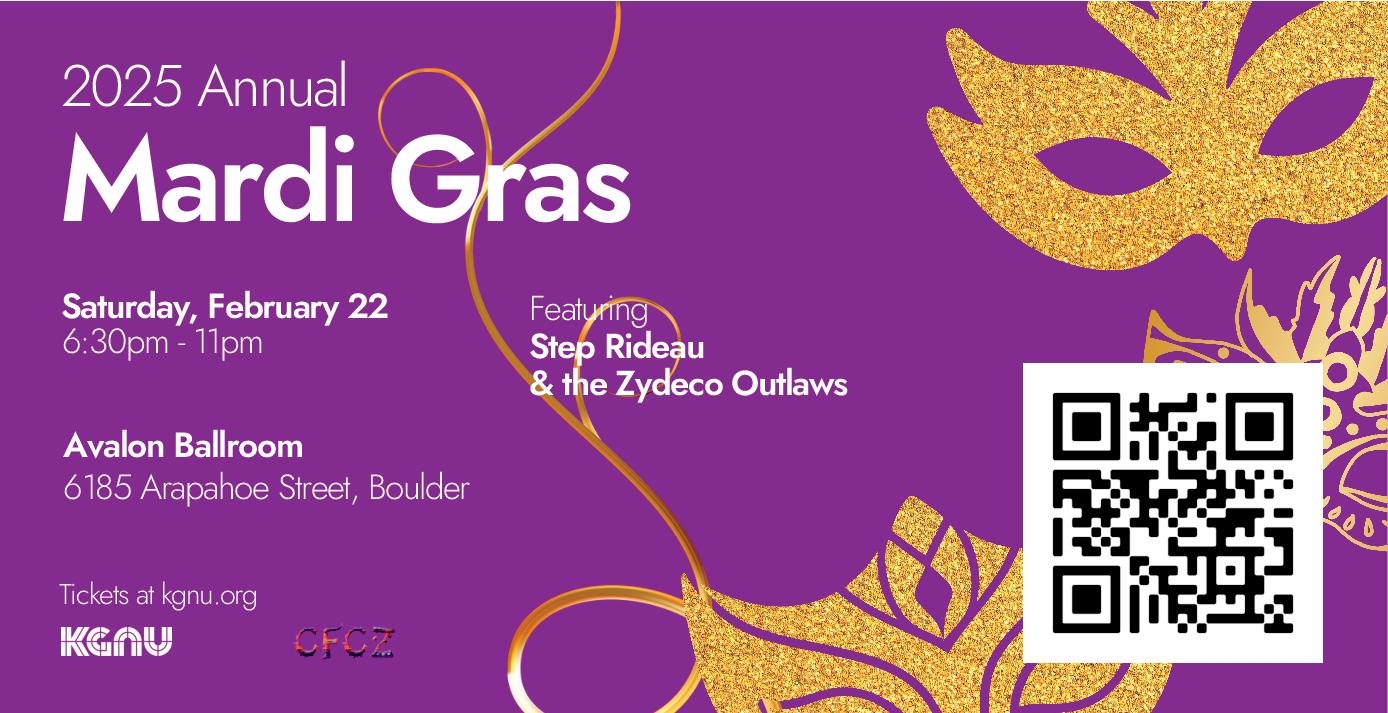















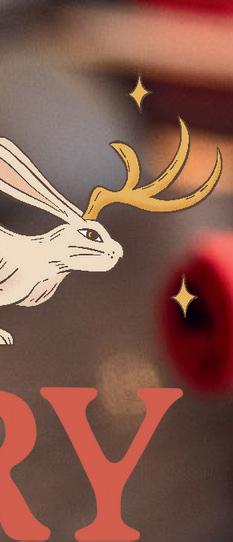

1117 pearl street boulder, CO




@highcountry.boulder

local ingredients, palate - carnivore to vegan, cocktails


New Western Cuisine



favorite spot 303-284-4473 and inspired dishes for every to zero-proof... awaits.





Whe re ce nturie s of culinary exce lle nce ge t a f re s h touch. S us hi, mode rn Japane s e, and hand-craf te d cock tails
Doctor-turned-chef ditches the pills and prescribes food for
what ails you
BY JOHN LEHNDORFF
During the 30 years Glenn Lopate worked as a neurologist at Washington University in St. Louis, he prescribed powerful drugs to patients suffering from nerve damage and other diseases. He also talked with thousands of people about their dietary habits. One thing became clear to him: Ultra-processed and fast foods are the biggest threat to good health.
“Processed food — and especially sugar — is a main culprit and driver of poor eating habits,” Lopate says. “Ultraprocessed food is pushed on our population. It’s made to make you want to have more. It tastes ‘good’ because it contains so much salt, fat and sugar.”
Now retired from medicine, Lopate
opened The Doctor’s Cuisine (thedoctorscuisine.com), a personal chef business in Longmont specializing in medically prescribed diets.
“I provide prepared meals for clients whether they are gluten sensitive, lactose intolerant or diabetic,” he says. “One of my clients had kidney failure and another one had a digestive tract disorder.”
Although he’s no longer Dr. Lopate, if a client asks for dietary advice, he’s willing to share. “I can go into someone’s house, look in their cupboard and kitchen and help them make their everyday cooking healthier,” he says.

Lopate reflects a growing trend of medical practitioners across the nation “prescribing” fresh produce and meats to
patients. For lower-income patients, connections to local food banks are made.
Lopate is a volunteer cook at Longmont’s Our Center and also caters food for yoga and health-centered retreats.
It takes more than prescribing a “Just say NO” approach to fast food. That same tactic failed to reduce drug use back in the 1960s. According to Lopate, you have to understand the underlying craving and replace it with real food.
“As long as you are eating the right food, then you can eat what you feel you need to eat and not feel deprived.”
One health-enhancing life hack Lopate and many nutrition experts recommend is to only shop around the outside edge of a supermarket.

“Meat, seafood, bread, and fruits and vegetables — the fresh stuff is on the perimeter,” he says. “Minimize what you buy in the middle aisles where many of the processed foods are. If it comes in a box, try not to buy it.”
A second rule of thumb is to avoid products containing more than five ingredients, especially ones you can’t easily identify. The physician-turned-chef follows his own advice cooking in his home kitchen in Longmont.
“I like the Mediterranean diet with a couple of tweaks,” he says. “The Mediterranean diet is fruits and vegetables, whole grains, olive oil, yogurt and a little bit of meat or fish once or twice a week. There’s no processed food in it at all.”
Lopate insists he’s not a dietary Grinch.
“There’s nothing wrong with having an indulgence every once in a while, something that’s not really what you’re supposed to eat because it tastes good,” he says. “Just not every day.”

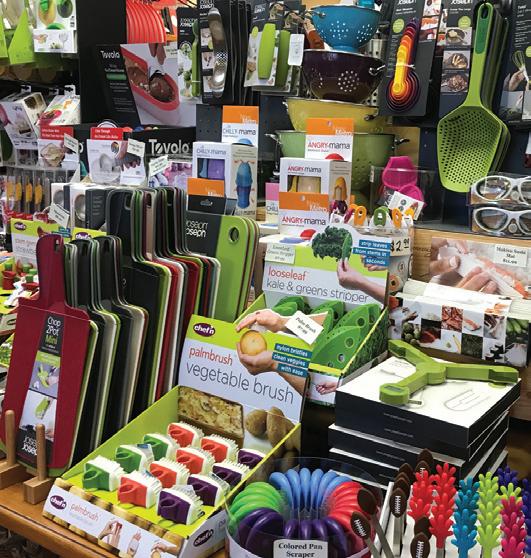




Stout Month is back at Mountain Sun for its 30th year. More than two dozen stouts will be poured at the brewery’s Boulder, Longmont and Denver locations.



Two stouts — Longmont’s Left Hand Brewing Co. Mexican Hot Chocolate Milk Stout and Psychotic Balaclava Horchata Stout from 300 Suns Brewing — are among the local winners of the recent inaugural Colorado Brewers Cup. Other Boulder County medal winners include Spirit of the West (Westbound & Down), El Poblano Borracho (Liquid Mechanics), Stable of Stars (Primitive Beer), and Niwot After Dark (Fritz Family Brewers). Find a full list of winners: coloradobeer.org/bc25
Bookmark Cafe is the new name for the coffee spot located over the creek at the Boulder Public Library’s main branch. Applications are open for BVSD’s Middle School Iron Chef Competition for teams of two to four students and one adult coach cooking global recipes live on March 19 in Boulder. The deadline to apply is Feb. 28. food.bvsd.org/programs/junioriron-chef-competition-at-home
Denver Restaurant Week is March 7-16 and features fixedprice meals. Participating metro eateries include Via Toscana and The Melting Pot in Louisville, Jill’s Restaurant and Cafe Aion in Boulder and Broomfield’s Vinca Restaurant. https://bit. ly/3EtChFp
If you operate a restaurant, bakery or other commercial kitchen, share how the current high egg prices and shortages are impacting your business. Email: nibbles@boulderweekly.com
“There is a simple memory aid that you can use to determine whether it is the correct time to order chocolate: any month whose name contains the letter A, E, or U is the proper time for chocolate.”
– Sandra Boynton
John Lehndorff hosts Radio Nibbles, a weekly local food program, on KGNU, 88.5 FM. Podcasts: kgnu.org/category/ radio-nibbles








BY RODNEY COATES THE CONVERSATION
Ending the fentanyl crisis won’t be easy. The U.S. has an addiction problem that spans decades — long predating the rise of fentanyl — and countless attempts to regulate, legislate and incarcerate have done little to reduce drug consumption. Meanwhile, the opioid crisis alone costs Americans tens of billions of dollars each year.
With past policies having failed to curb fentanyl deaths, President Donald Trump is turning to another tool to fight America’s drug problem: trade policy.
During his presidential campaign, Trump pledged to impose tariffs on Canada and Mexico if they didn’t halt the flow of drugs across U.S. borders, and on China if it didn’t do more to crack down on the production of chemicals used to make fentanyl. Trump reiterated his plan on his first day back in office, and on Feb. 1, he made good on that threat, imposing tariffs on all three countries and citing fentanyl as a key reason.
History shows that government efforts to curb drug use often have little success. While the human toll of fentanyl is undeniable, the real question is whether tariffs will work — or worsen what’s already a crisis.
The first real attempt to regulate drugs in the U.S. occurred in 1890, when, amid
rampant drug abuse, Congress enacted a law taxing morphine and opium.
Subsequent bans and taxes leveled on opium (1909) and marijuana (1937) failed to curb drug use; the same can be said of the comprehensive Controlled Substances Act of 1970 and Richard Nixon’s “War on Drugs.”

These policies have generally failed to curb drug supply and use, while also causing significant harm to people and communities of color. For example, between 1980 and 1997, the number of incarcerations for nonviolent drug offenses went from 50,000 to 400,000. The share of high school seniors using drugs dipped only slightly over the same period, from 65% in 1980 to 58% in 1997.


industrial subsidies and protectionist policies don’t do much to stimulate broad economic growth at home — but they raise prices for consumers and can even lead to global economic instability. History also shows that tariffs don’t work especially well as negotiating tools, failing to effect significant policy changes in target countries.
Over the course of Trump’s first term, the average effective tariff rate on Chinese imports went from 3% to 11%.









Now, it looks like the U.S. is shifting toward using tariffs — but research suggests those will not lead to better outcomes either, and could actually cause considerable harm.
America’s experiments with tariffs can be traced back to the founding era with the passage of the Tariff Act of 1789. This long history has shown that tariffs,







yl — he did so in his first term. But while China made some policy changes in response, such as adding fentanyl to its controlled substances list in 2019, fentanyl deaths in the U.S. continued to rise. Currently, China still ranks as the No. 1 producer of fentanyl precursors, or chemicals used to produce illicit fentanyl. And there are others in the business: India, over that same period, has become a major producer of fentanyl.




But while imports from China fell slightly, the overall trade relationship didn’t change much: China remains the second-largest supplier of goods to the U.S.
The tariffs did have some benefit — for Vietnam and other nearby countries with relatively low labor costs.
Essentially, the tariffs on China caused production to shift, with global companies investing billions of dollars in competitor nations.
This isn’t the first time Trump has used trade policy to pressure China on fentan-


Drugs have been pervasive throughout U.S. history. Other nations are dealing with this problem with more success, favoring treatment over criminalization. They realized demand is what fuels the illicit market. As any economist will tell you, supply will find a way if you don’t limit the demand. That’s why treatment works and bans don’t.
The U.S. government’s ability to control the production of these drugs is limited at best. The problem is that new chemical products will continually be produced. What the U.S. needs is a more systematic approach to deal with the demand that’s fueling the drug crisis.
Rodney Coates is a professor of critical race and ethnic studies at Miami University. The Conversation is a nonprofit, independent news organization featuring academic experts.


















































































